I need to make sure each heading includes "bluestone walkway" and is descriptive of a unique idea/style/design.Bluestone walkways offer an unparalleled combination of natural beauty, durability, and versatility that can transform any outdoor space into an elegant landscape feature. These stunning stone paths, crafted from premium Pennsylvania or New York bluestone, provide homeowners with countless design possibilities to enhance their property's curb appeal and functionality. Whether you're drawn to clean, modern lines or prefer the rustic charm of irregular patterns, bluestone adapts seamlessly to complement any architectural style. From simple straight pathways to elaborate curved designs with integrated landscaping, these 20 inspiring bluestone walkway ideas will help you create a stunning garden path that serves as both a practical route and a captivating focal point for years to come.
1. Straight Linear Bluestone Walkway with Clean Geometric Lines
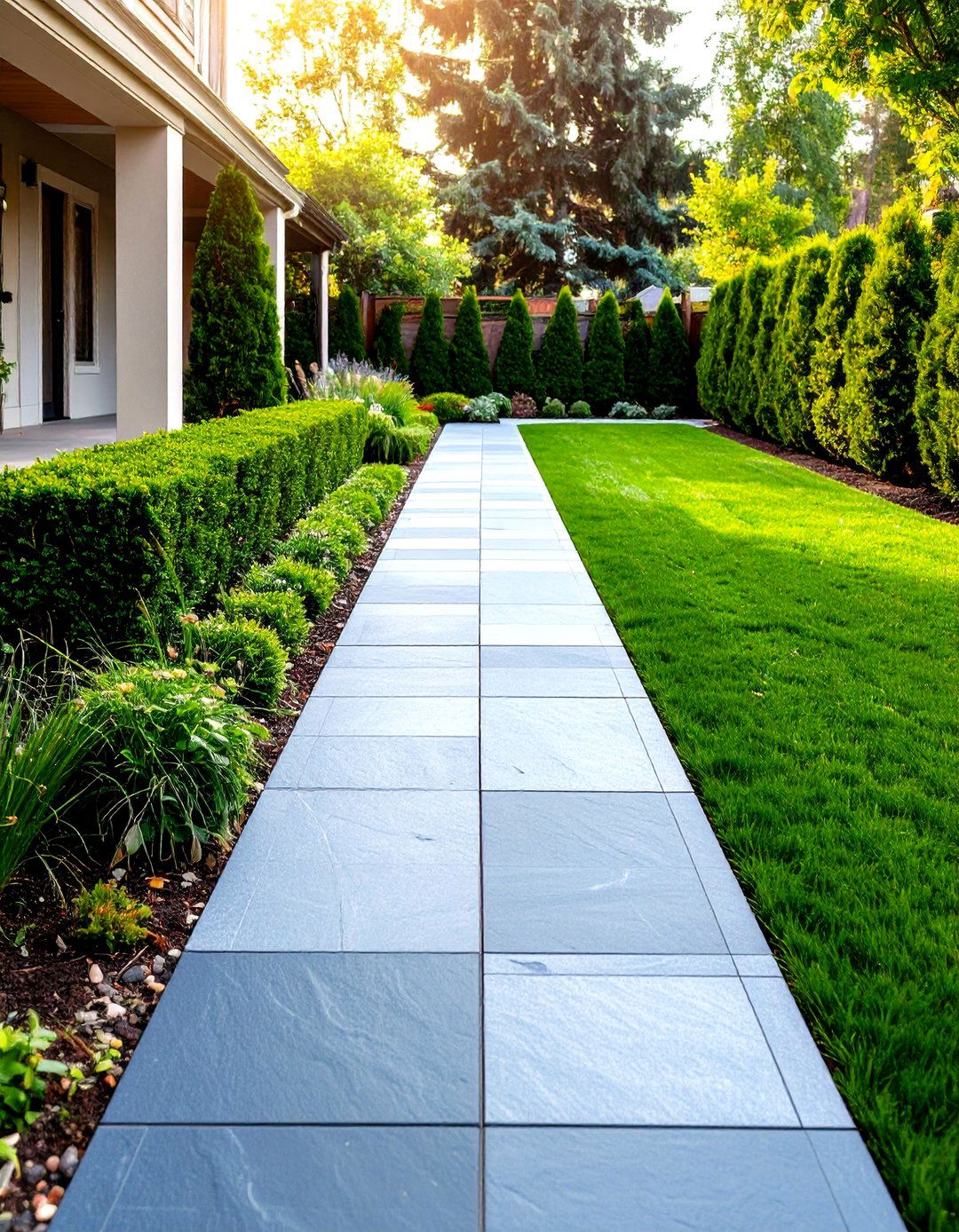
The epitome of timeless elegance, a straight linear bluestone walkway creates an impressive entrance that guides visitors directly to your front door with purposeful precision. These pathways feature evenly spaced rectangular bluestone slabs laid in perfect alignment, offering a clean and sophisticated aesthetic that complements both traditional and contemporary home designs. The geometric consistency of this design emphasizes order and structure while maintaining the natural beauty inherent in bluestone's rich color variations. For optimal visual impact, consider using larger format stones with minimal spacing between slabs, creating an uninterrupted flow that draws the eye forward. This classic approach works particularly well when paired with manicured landscaping featuring boxwood hedges or ornamental grasses that frame the pathway without overwhelming its structured appearance.
2. Curved Meandering Bluestone Walkway Through Garden Landscape
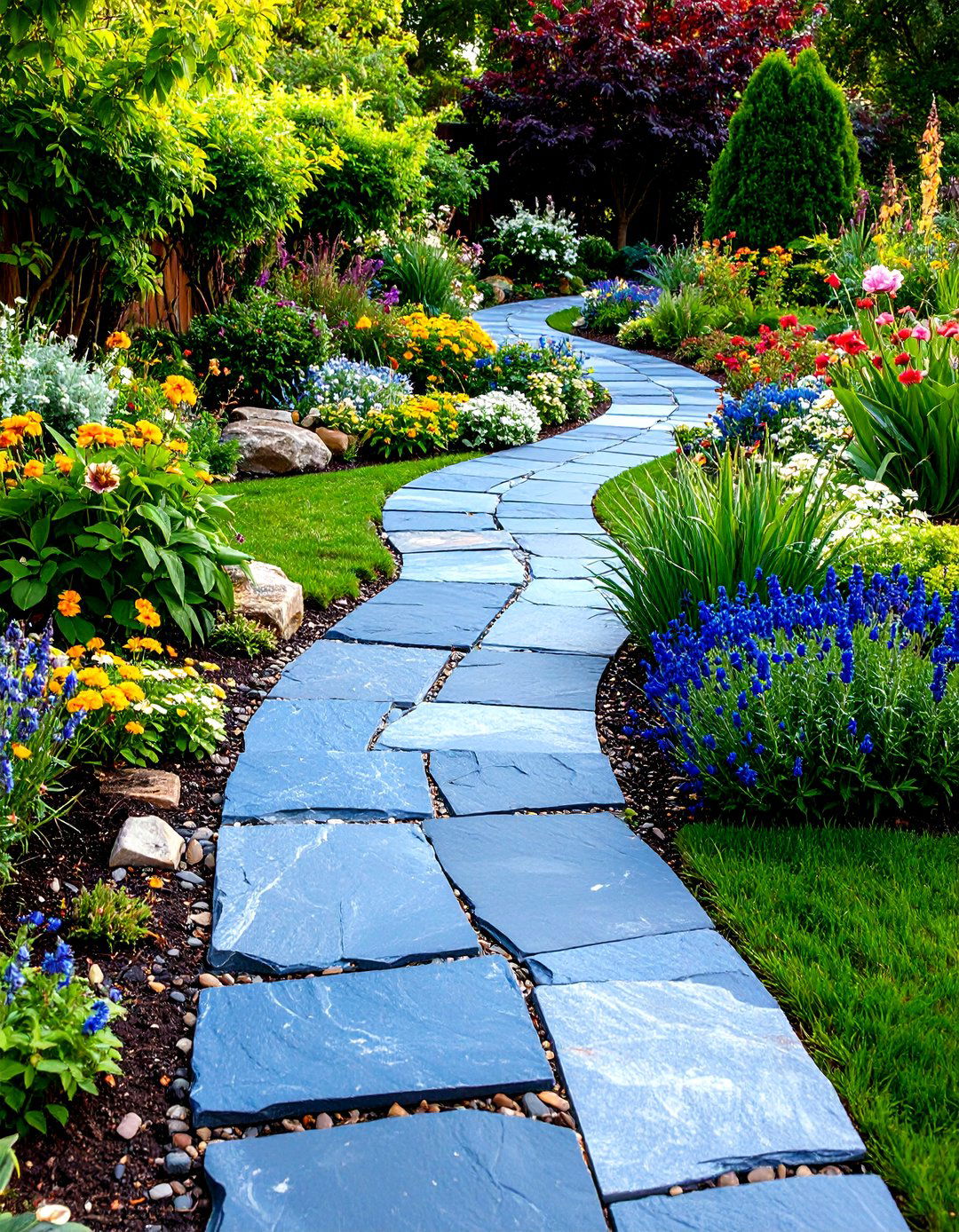
Bringing organic flow to your outdoor space, a curved meandering bluestone walkway creates an inviting journey that encourages leisurely exploration of your garden's natural beauty. Unlike rigid straight paths, these gracefully winding routes follow the natural contours of your landscape, creating intimate moments and surprise views around each gentle bend. The irregular placement of varying-sized bluestone slabs enhances the pathway's natural feel while providing excellent durability for high-traffic areas. Strategic placement of flowering perennials, ornamental shrubs, and decorative boulders along the curved edges softens the stone's hard edges and creates a seamless transition between the walkway and surrounding plantings. This design approach works exceptionally well in larger yards where the pathway can weave between existing trees, garden beds, and landscape features, transforming a simple walk into an engaging outdoor experience.
3. Irregular Pattern Bluestone Walkway with Natural Mosaic Effect
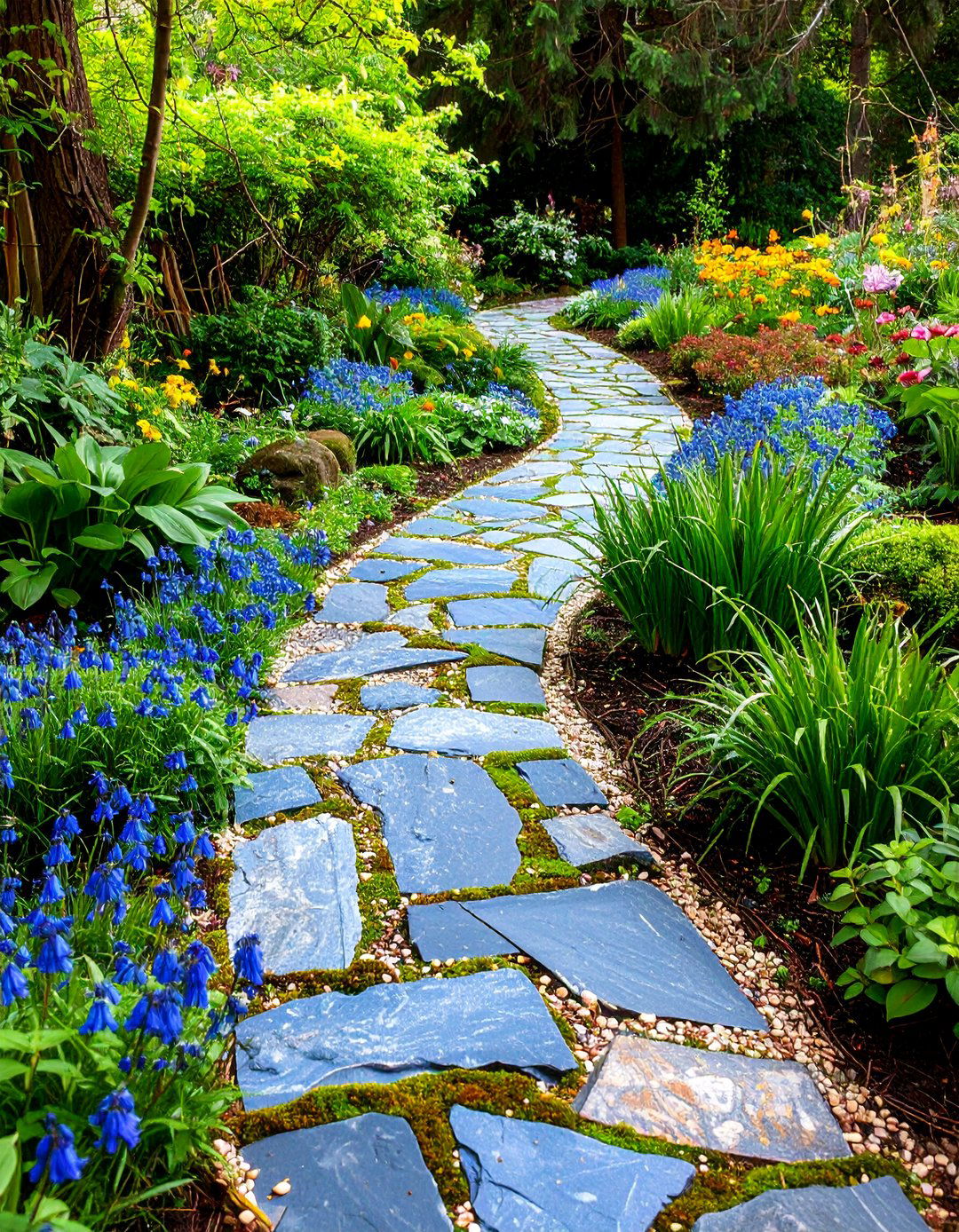
Creating visual drama through intentional randomness, an irregular pattern bluestone walkway features stones of varying shapes and sizes arranged in a natural mosaic that mimics the spontaneous beauty found in nature. This organic approach celebrates the unique characteristics of each individual stone, allowing their natural edges and varied dimensions to create an artistic composition underfoot. The seemingly random placement requires careful planning to ensure proper fit and stability while maintaining the carefree appearance that makes this style so appealing. Gaps between irregularly shaped stones can be filled with decorative gravel, moss, or low-growing ground cover plants that add texture and color contrast. This rustic approach works beautifully in cottage-style gardens, woodland settings, or any landscape design that emphasizes natural beauty over formal structure, creating a pathway that feels like it has been part of the landscape for decades.
4. Running Bond Pattern Bluestone Walkway with Brick-Like Layout
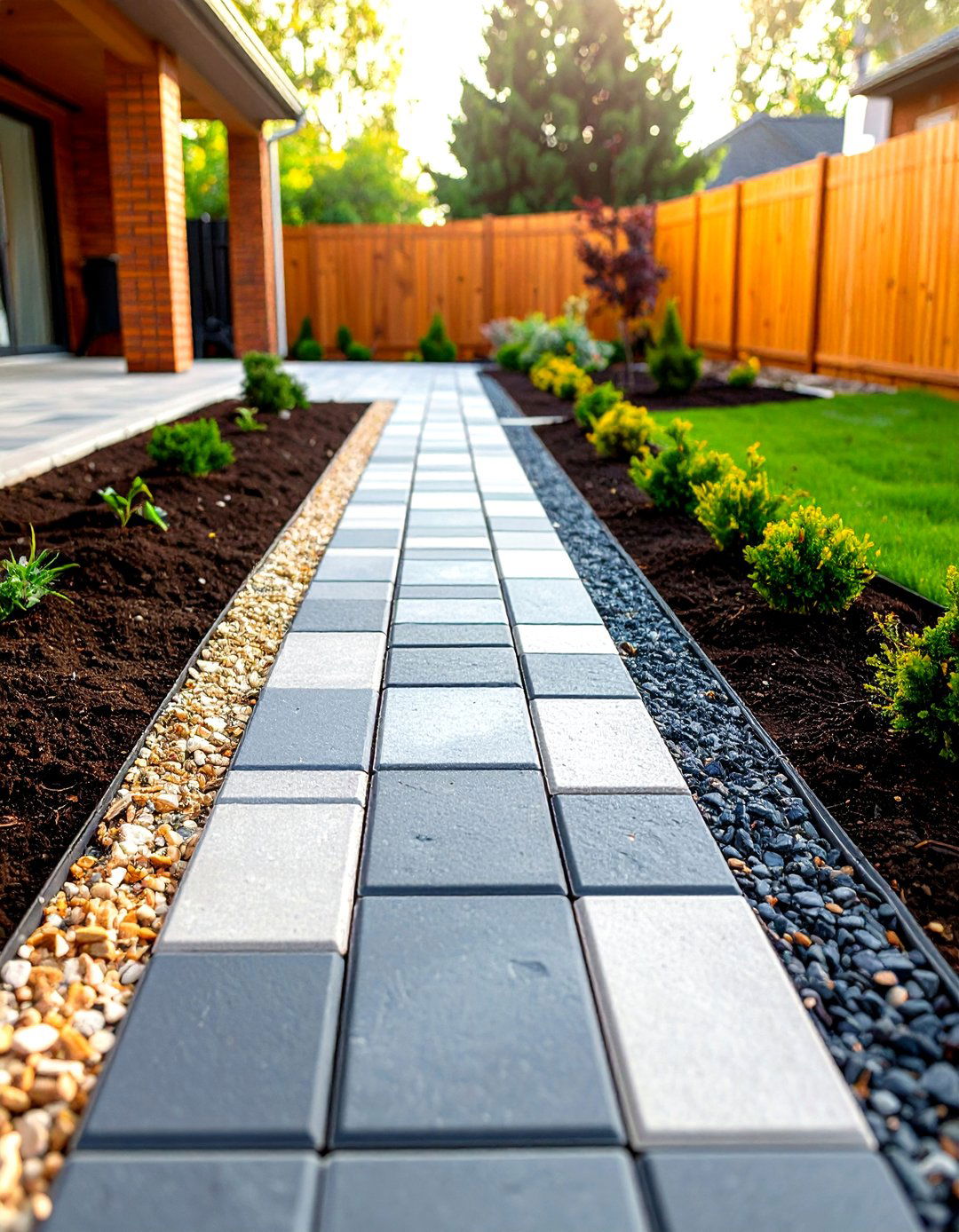
Taking inspiration from traditional masonry techniques, a running bond pattern bluestone walkway arranges rectangular stones in a staggered formation that creates visual rhythm and sophisticated architectural appeal. Each row of stones is offset by half a stone length from the row above and below, creating a classic brick-like pattern that adds movement and interest to the pathway surface. This time-tested layout provides excellent structural stability while offering a refined appearance that works equally well with historical homes and contemporary designs. The consistent spacing between stones allows for uniform joint lines that can be filled with matching stone dust, contrasting gravel, or polymeric sand for different aesthetic effects. Consider varying the stone sizes within the pattern to create subtle variations that prevent the design from becoming too predictable while maintaining the overall geometric integrity that makes this pattern so enduringly popular.
5. Bluestone Walkway with Integrated Gravel Border Accents
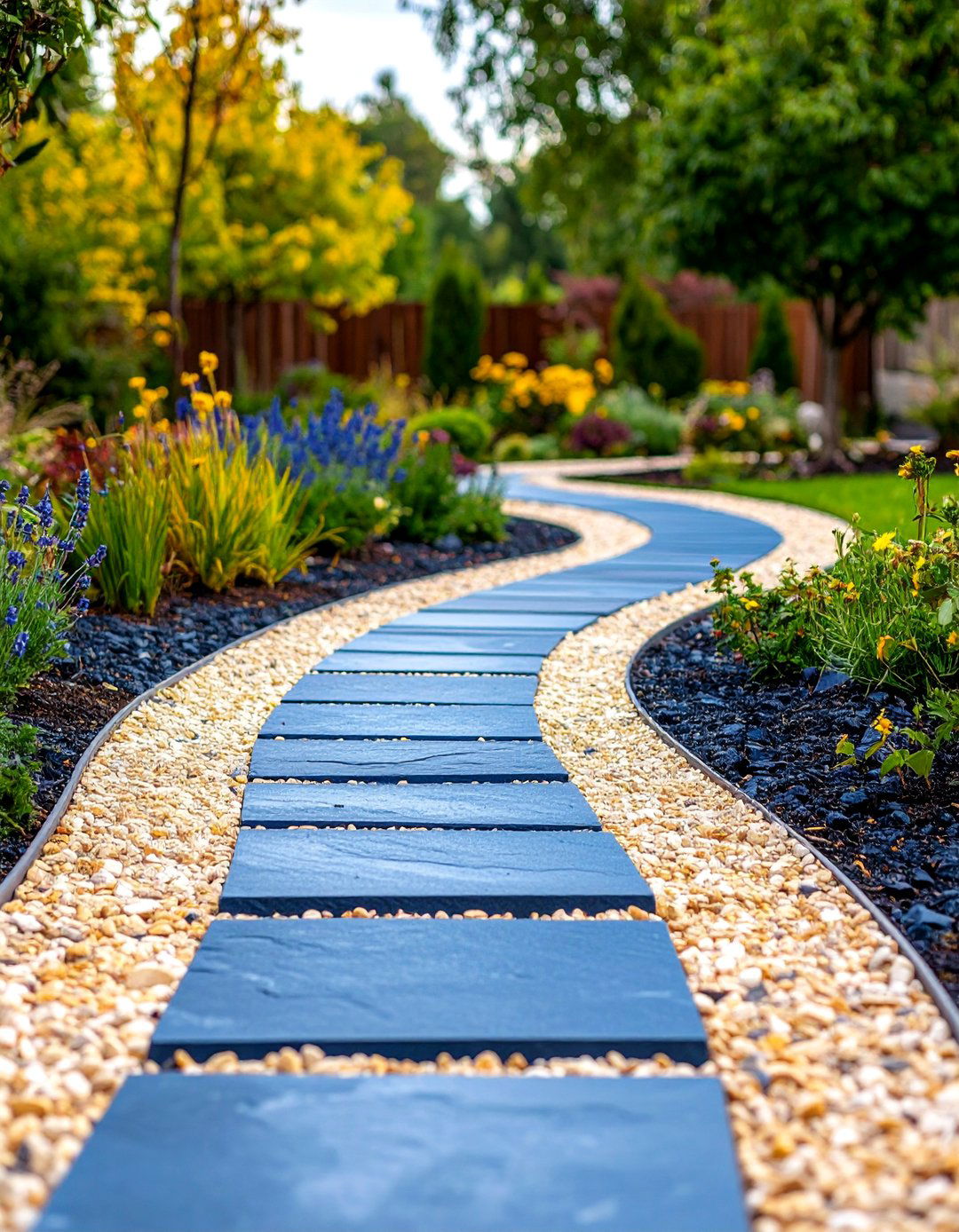
Combining two complementary materials, a bluestone walkway with integrated gravel border accents creates sophisticated contrast while improving both drainage and visual definition along the pathway edges. The crisp lines where bluestone meets decorative gravel establish clear boundaries that help define the walkway's footprint within the broader landscape design. Choose gravel colors that either complement or contrast with your bluestone's natural hues – warm beige or tan gravels enhance the stone's earthy tones, while darker charcoal creates dramatic definition. This design approach also provides practical benefits, as the gravel borders help channel water away from the stone surface and provide stable edging that prevents soil erosion. Installation involves careful attention to proper grading and the use of edging materials to keep gravel confined within designated areas. The result is a professional-looking pathway that feels both structured and natural.
6. Herringbone Pattern Bluestone Walkway with Classic European Style
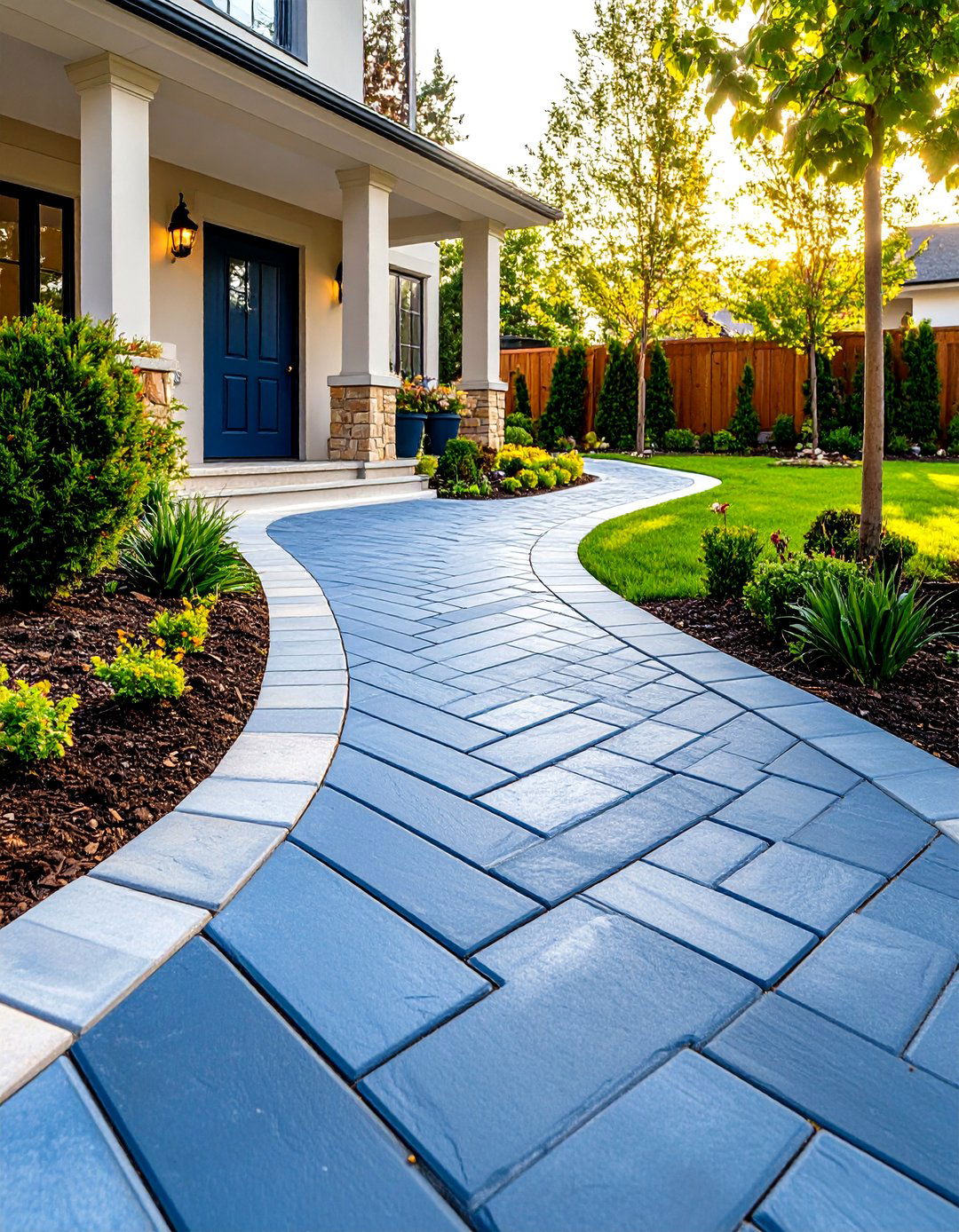
Drawing from centuries of European stone masonry tradition, a herringbone pattern bluestone walkway creates stunning visual complexity through the strategic arrangement of rectangular stones in alternating diagonal directions. This sophisticated layout features stones placed at 90-degree angles to each other, forming a distinctive zigzag pattern that adds movement and elegance to any pathway. The interlocking nature of the herringbone design provides exceptional structural stability, making it ideal for areas that experience heavy foot traffic or need to support occasional vehicle access. While more labor-intensive to install than simpler patterns, the herringbone layout creates an unmistakably upscale appearance that significantly enhances property value and curb appeal. This pattern works particularly well when used for main entrance walkways, formal garden paths, or connecting pathways between outdoor entertaining areas where visual impact is a primary consideration for the overall landscape design.
7. Bluestone Walkway with Moss-Filled Joints for Aged Character
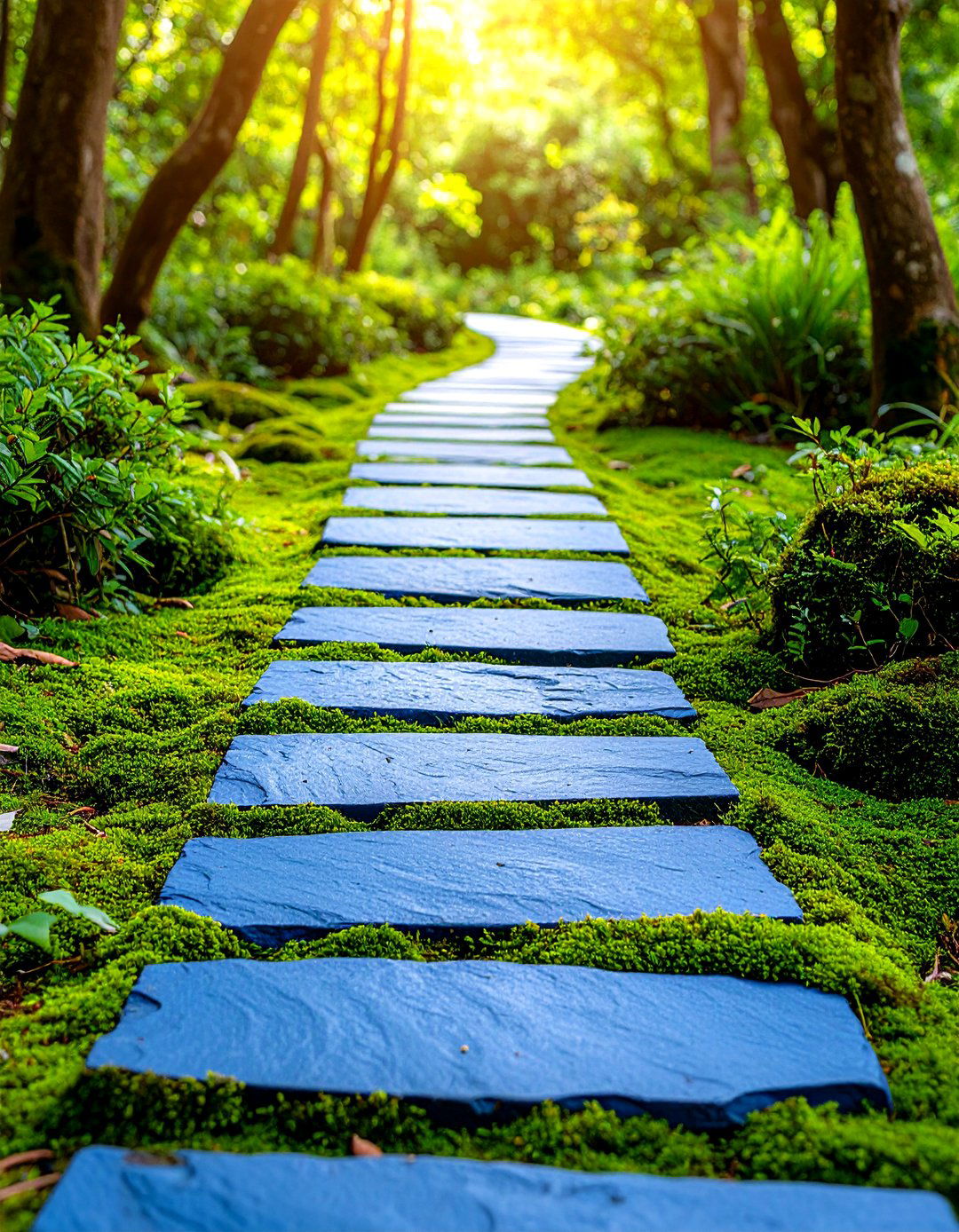
Achieving the timeless beauty of an established garden, a bluestone walkway with moss-filled joints creates an enchanting pathway that appears to have been part of the landscape for generations. Natural moss growth between stones softens the hard edges of the bluestone while adding verdant color and organic texture that changes subtly throughout the seasons. This design works particularly well in shaded areas where moisture retention encourages healthy moss development, creating a living carpet between stones that requires minimal maintenance once established. To encourage moss growth, maintain consistent moisture in the joint areas and avoid using herbicides or harsh cleaning products that might inhibit natural colonization. The result is a pathway that feels authentically aged and perfectly integrated with woodland gardens, shade perennials, and naturalistic landscape designs. This approach appeals to gardeners who appreciate the beauty of controlled wildness and prefer landscapes that feel effortlessly established.
8. Contemporary Bluestone Walkway with Steel Edge Details
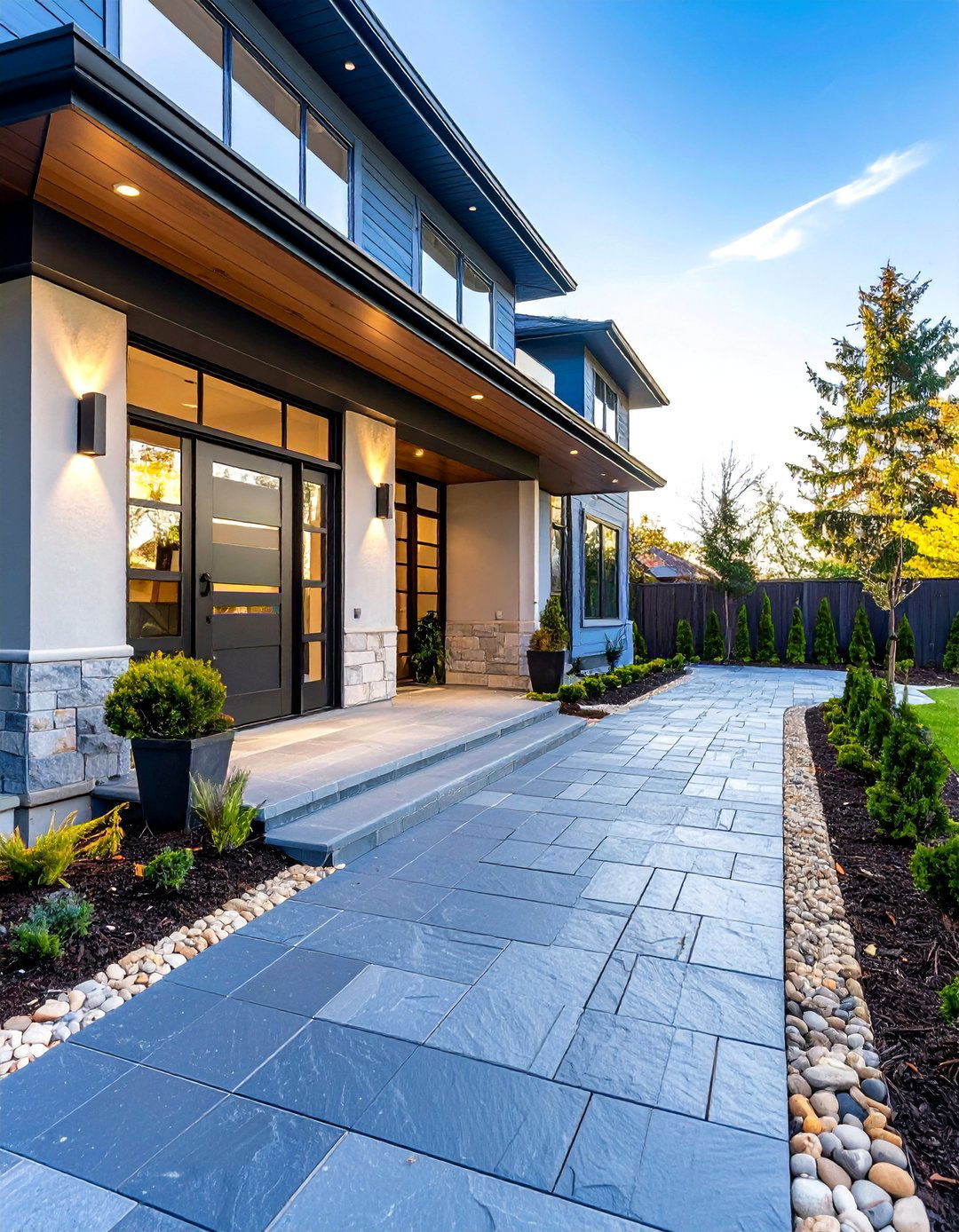
Merging natural stone with modern materials, a contemporary bluestone walkway with steel edge details creates striking contrast that emphasizes both the organic beauty of the stone and the precision of contemporary design elements. Thin steel edging strips provide crisp definition along the pathway edges while preventing soil migration and maintaining clean lines that complement modern architectural styles. The industrial aesthetic of weathering steel or painted metal edging creates sophisticated contrast against the natural texture and color variations of bluestone, resulting in a pathway that feels both grounded in nature and distinctly contemporary. This design approach works exceptionally well with modern homes featuring clean lines, large windows, and minimalist landscaping where every element is carefully considered for its contribution to the overall aesthetic. The steel edging also provides practical benefits by creating defined borders that simplify maintenance and prevent grass or ground cover from encroaching onto the walkway surface.
9. Stepping Stone Bluestone Walkway Through Groundcover Plants
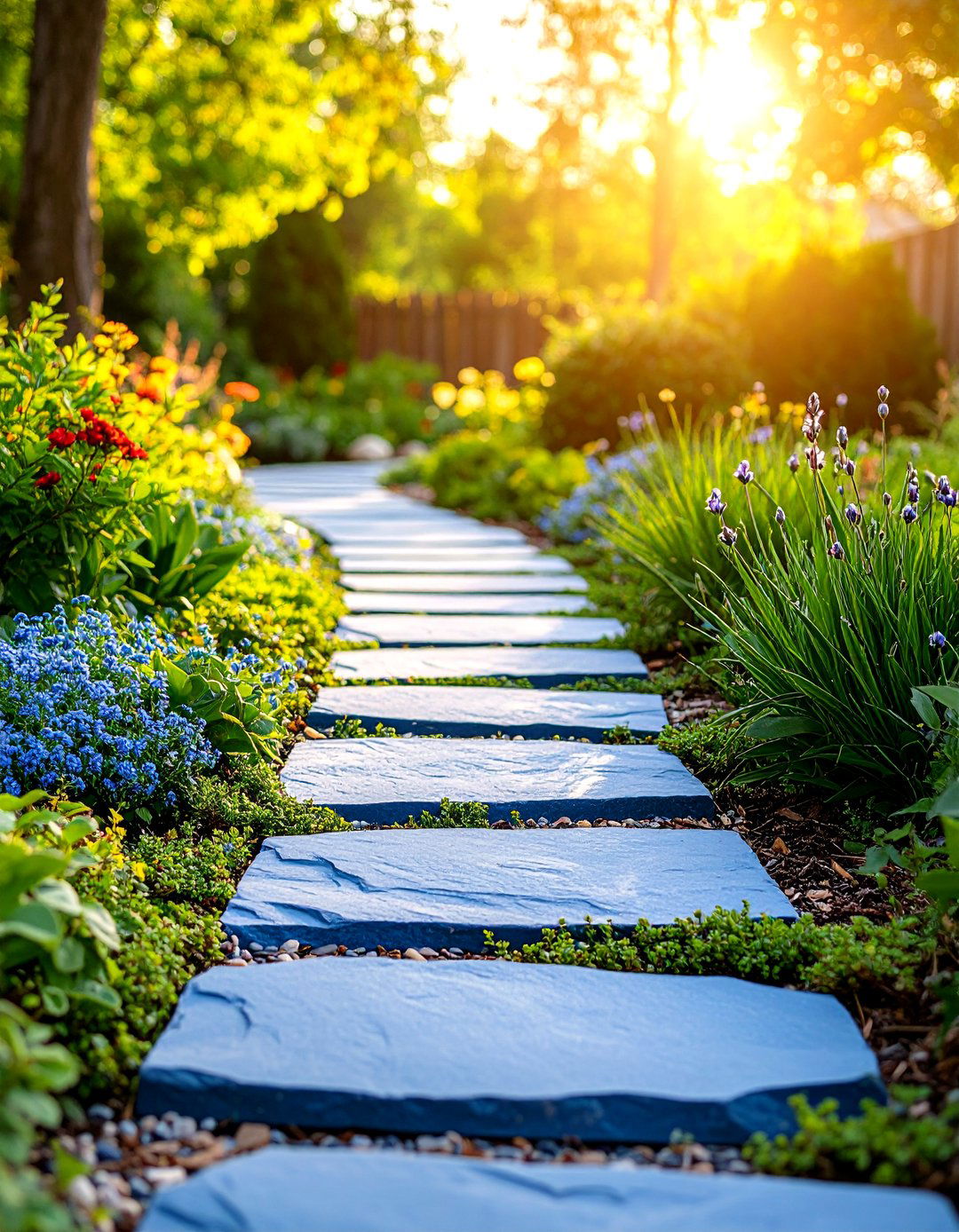
Creating an intimate connection with nature, a stepping stone bluestone walkway through groundcover plants offers a charming alternative to traditional continuous pathways that invites slower, more contemplative movement through the garden. Individual bluestone slabs are strategically spaced to accommodate natural walking rhythm while allowing low-growing plants to flourish in the spaces between stones. This design approach works beautifully with creeping thyme, ajuga, sedums, or other hardy groundcover varieties that can tolerate occasional foot traffic while providing seasonal color and texture. The spacing between stones should be carefully calculated based on average stride length, typically ranging from 18 to 24 inches center to center for comfortable walking. This style creates a softer, more integrated appearance than solid pathways while maintaining the durability and slip resistance that makes bluestone an excellent choice for outdoor applications. The result is a pathway that feels like a natural part of the garden ecosystem.
10. Bluestone Walkway with Integrated LED Lighting System

Transforming evening outdoor experiences, a bluestone walkway with integrated LED lighting system extends the usability and safety of your pathway while creating dramatic nighttime ambiance that highlights the stone's natural beauty. Small LED fixtures can be embedded between stones, installed along the edges, or integrated into retaining walls to provide subtle illumination that guides visitors safely while avoiding harsh lighting that might disrupt the garden's peaceful atmosphere. Modern LED technology offers energy-efficient operation, long lifespan, and the ability to customize color temperature and intensity to match your specific aesthetic preferences. Solar-powered options eliminate the need for electrical wiring while providing environmentally conscious operation that charges during the day and automatically illuminates at dusk. The gentle glow created by well-designed pathway lighting transforms the bluestone surface into a luminous river that creates magical evening scenes and extends outdoor entertaining possibilities throughout the year.
11. Multi-Level Bluestone Walkway with Integrated Steps
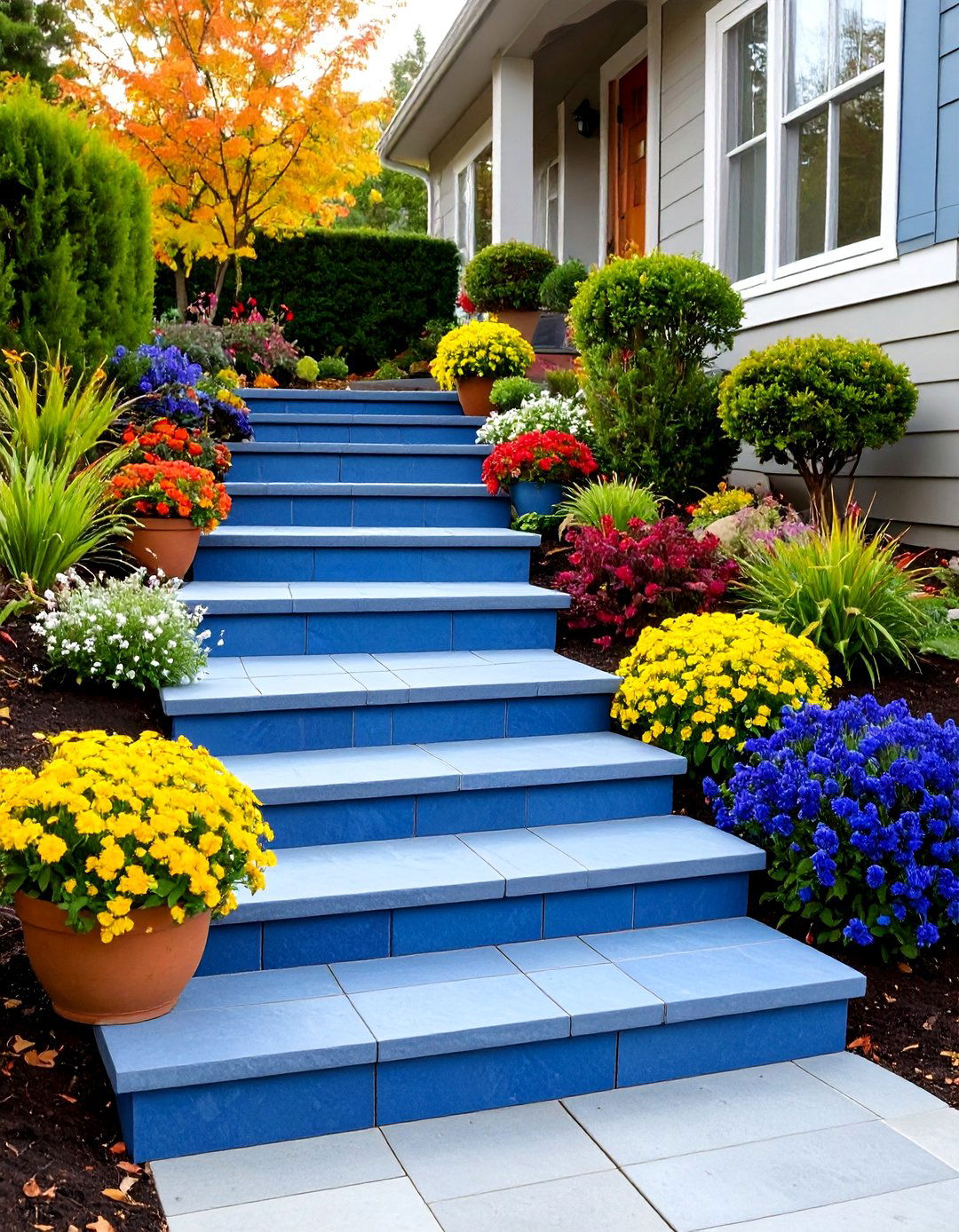
Addressing challenging terrain with elegant functionality, a multi-level bluestone walkway with integrated steps seamlessly navigates slopes and elevation changes while maintaining the pathway's visual continuity and structural integrity. This sophisticated design approach combines level walking surfaces with carefully proportioned steps that use matching bluestone treads and risers for a cohesive appearance. The integration of steps directly into the walkway design eliminates awkward transitions and creates smooth flow between different elevation levels in your landscape. Proper engineering ensures adequate drainage, appropriate rise and run dimensions for comfortable use, and sufficient tread depth for safety. This design technique works particularly well for sloped front yards, terraced gardens, or pathways that need to connect different outdoor living areas at varying elevations. The result is a professional-looking solution that turns challenging topography into an opportunity for creating dramatic visual interest and enhanced accessibility throughout your outdoor space.
12. Bluestone Walkway with Water Feature Integration
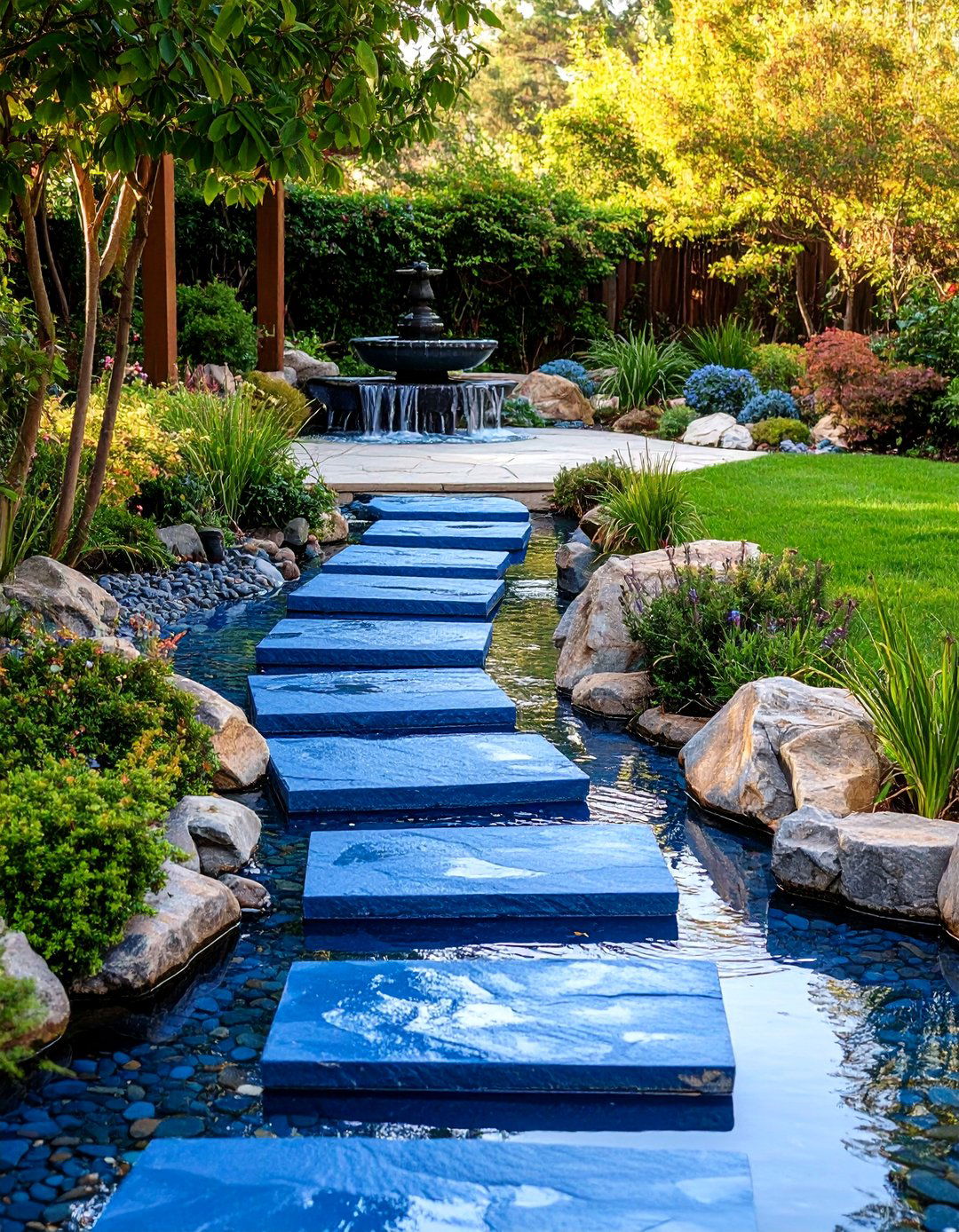
Bringing tranquil sounds and movement to your pathway experience, a bluestone walkway with water feature integration creates a sensory-rich journey that combines the solid permanence of stone with the dynamic beauty of flowing water. Strategic placement of small streams, shallow channels, or decorative fountains alongside or crossing the walkway adds another dimension to the garden experience while providing soothing background sounds that mask traffic noise and create peaceful outdoor environments. The natural affinity between bluestone and water creates visual harmony, as the stone's cool tones complement reflective water surfaces while providing safe, slip-resistant footing even in wet conditions. Design considerations include proper drainage, electrical requirements for pumps or lighting, and seasonal maintenance needs for water elements. This sophisticated approach works particularly well in formal gardens, meditation spaces, or areas where creating a spa-like atmosphere is desired, transforming a simple pathway into a destination that engages multiple senses.
13. Circular Pattern Bluestone Walkway Around Central Feature
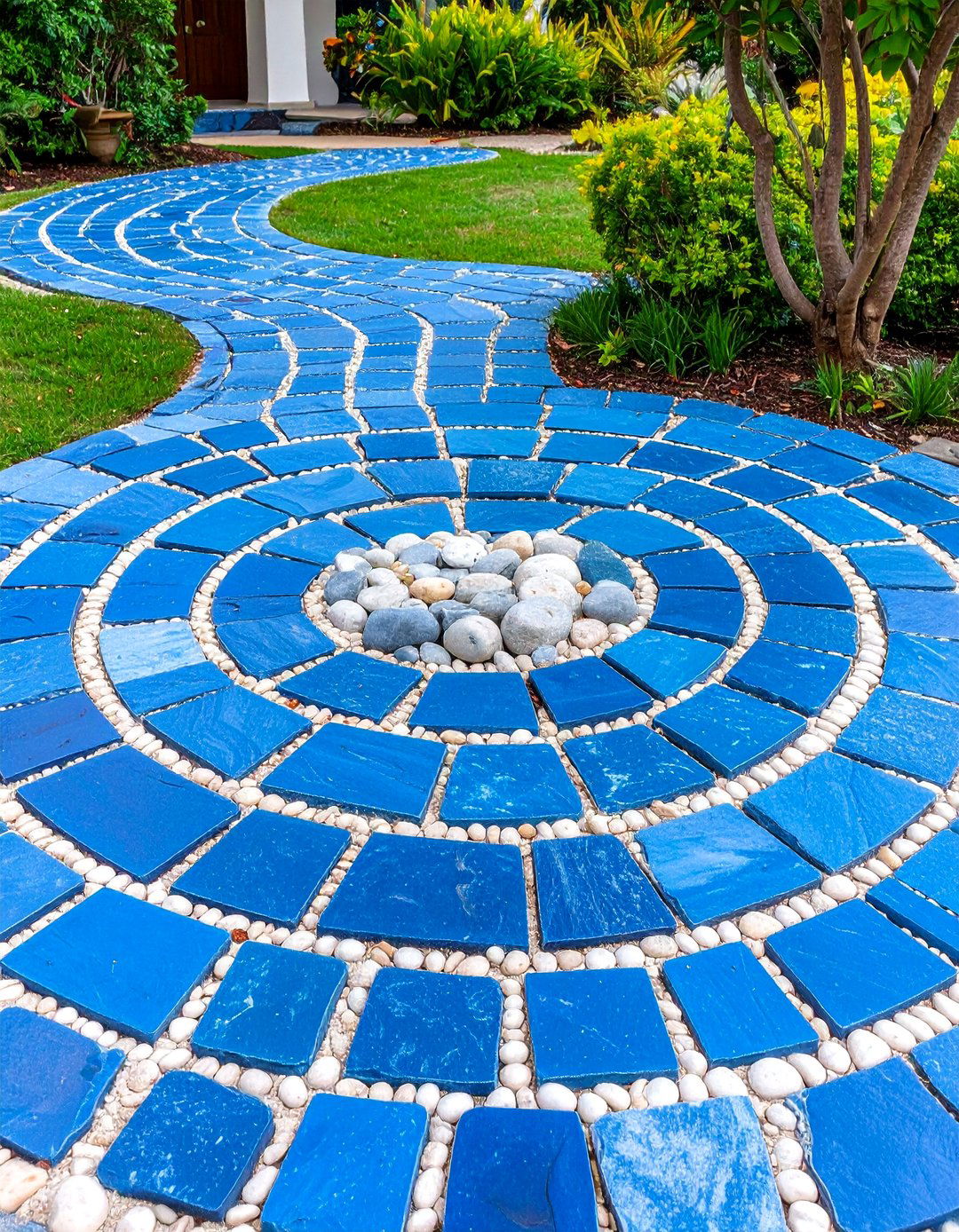
Creating focal drama through geometric design, a circular pattern bluestone walkway around a central feature draws attention to important landscape elements while providing an engaging alternative to traditional linear pathways. Whether surrounding a fountain, sculpture, specimen tree, or fire pit, the circular layout establishes clear visual hierarchy and encourages visitors to pause and appreciate the featured element from multiple angles. The curved installation requires careful planning and often custom cutting of stones to achieve smooth, consistent curves that maintain proper joint spacing and structural integrity. This design approach works particularly well in formal gardens, courtyard settings, or as termination points for longer pathways where creating a sense of arrival is important. The circular pattern can be achieved using wedge-shaped custom-cut stones or by carefully arranging rectangular stones with wider joints on the outer edges, depending on the desired aesthetic and budget considerations for the project.
14. Bluestone Walkway with Contrasting Brick Border Details
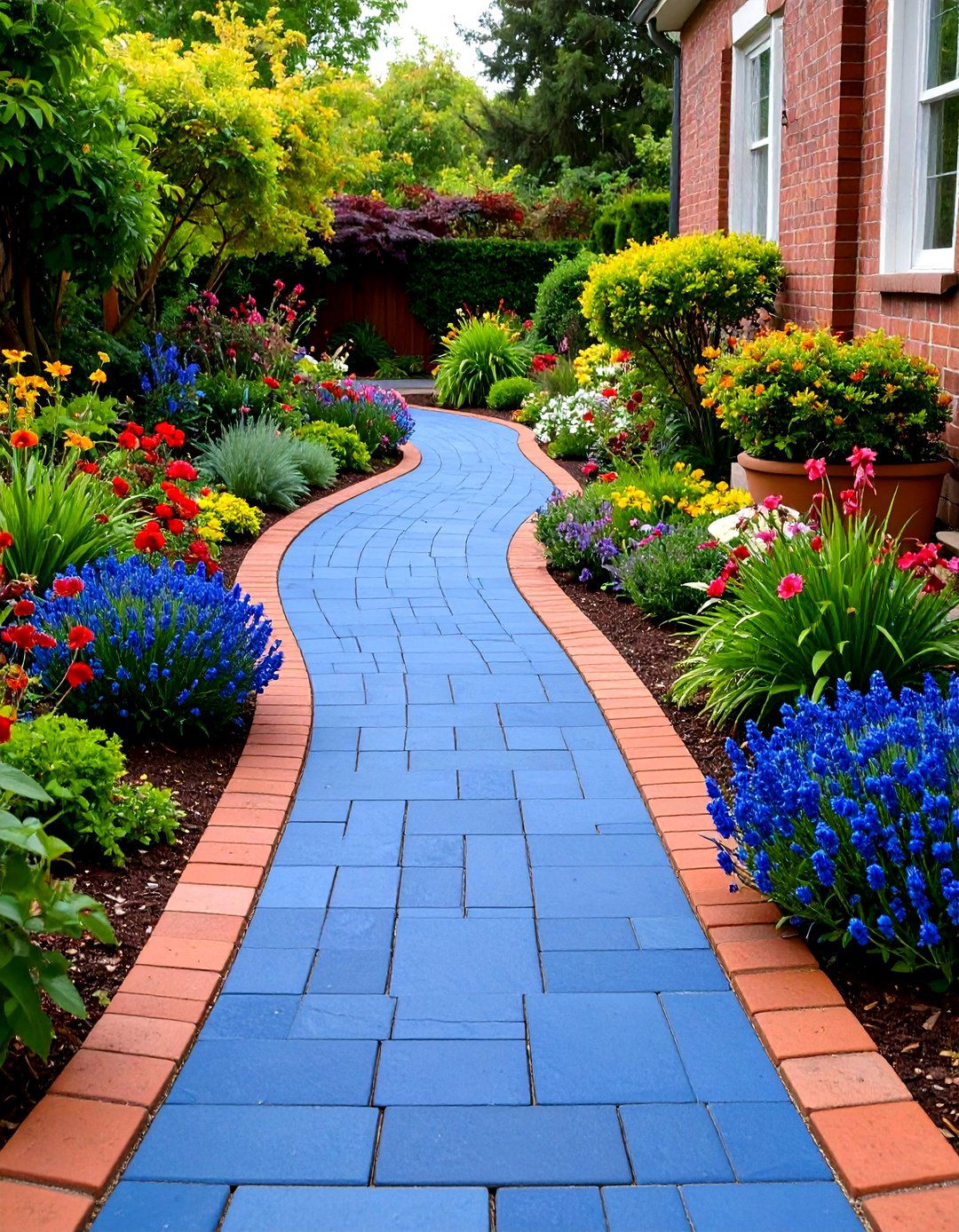
Combining timeless materials, a bluestone walkway with contrasting brick border details creates sophisticated visual definition while honoring traditional landscape design principles that have remained popular for centuries. The warm terracotta tones of brick create striking contrast against bluestone's cooler gray and blue hues, establishing clear pathway boundaries while adding architectural interest that complements both traditional and transitional home styles. This classic combination works particularly well when the brick matches or coordinates with existing architectural elements such as home foundations, chimneys, or garden walls, creating visual continuity throughout the landscape design. Installation requires careful attention to proper edging and base preparation to ensure both materials remain level and stable over time. The brick borders can range from simple single-course edges to more elaborate patterns that incorporate soldier courses or decorative layouts, allowing customization to match the overall formality level desired for the outdoor space.
15. Natural Cleft Bluestone Walkway with Rustic Texture
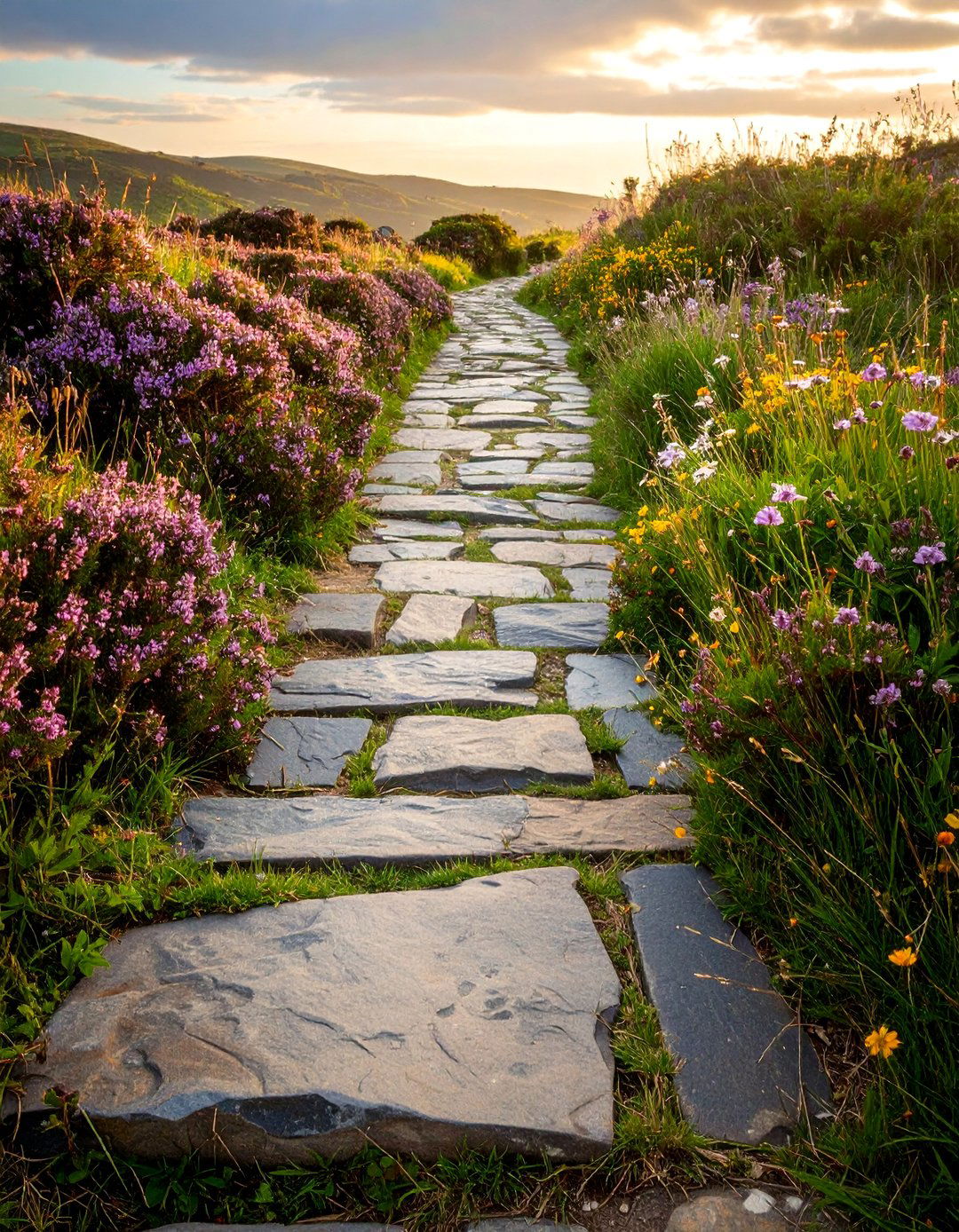
Celebrating the raw beauty of natural stone, a natural cleft bluestone walkway with rustic texture showcases the authentic characteristics that make this material so prized for outdoor applications. The naturally split surface retains the layered texture created during quarrying, resulting in subtle variations in height and surface pattern that create visual interest while providing excellent traction in all weather conditions. This finish emphasizes the stone's geological origins and works particularly well in informal garden settings, cottage-style landscapes, or anywhere that a more relaxed, natural aesthetic is desired over polished formality. The irregular surface texture requires careful installation techniques to ensure level transitions between stones while preserving the natural character that makes this finish so appealing. When combined with naturalistic plantings such as native perennials, ornamental grasses, or wildflower meadows, natural cleft bluestone creates pathways that feel authentically connected to the surrounding environment and regional landscape character.
16. Thermal Finish Bluestone Walkway with Uniform Texture

Providing refined elegance through controlled surface treatment, a thermal finish bluestone walkway with uniform texture offers sophisticated consistency that complements formal landscape designs and contemporary architectural styles. The thermal finishing process creates an even, slightly textured surface that maintains excellent slip resistance while eliminating the natural variations found in cleft finishes, resulting in a more predictable and refined appearance. This finish works particularly well for main entrance walkways, formal garden paths, or areas where a polished appearance is desired without sacrificing the practical benefits of natural stone. The uniform texture also facilitates easier maintenance and cleaning compared to more irregular surface finishes, making it an excellent choice for high-visibility areas or locations where consistent appearance is important. When combined with formal plantings such as clipped hedges, geometric garden beds, or architectural landscape elements, thermal finish bluestone creates pathways that emphasize precision and intentional design while maintaining the inherent beauty of natural stone.
17. Bluestone Walkway with Sculptural Element Integration
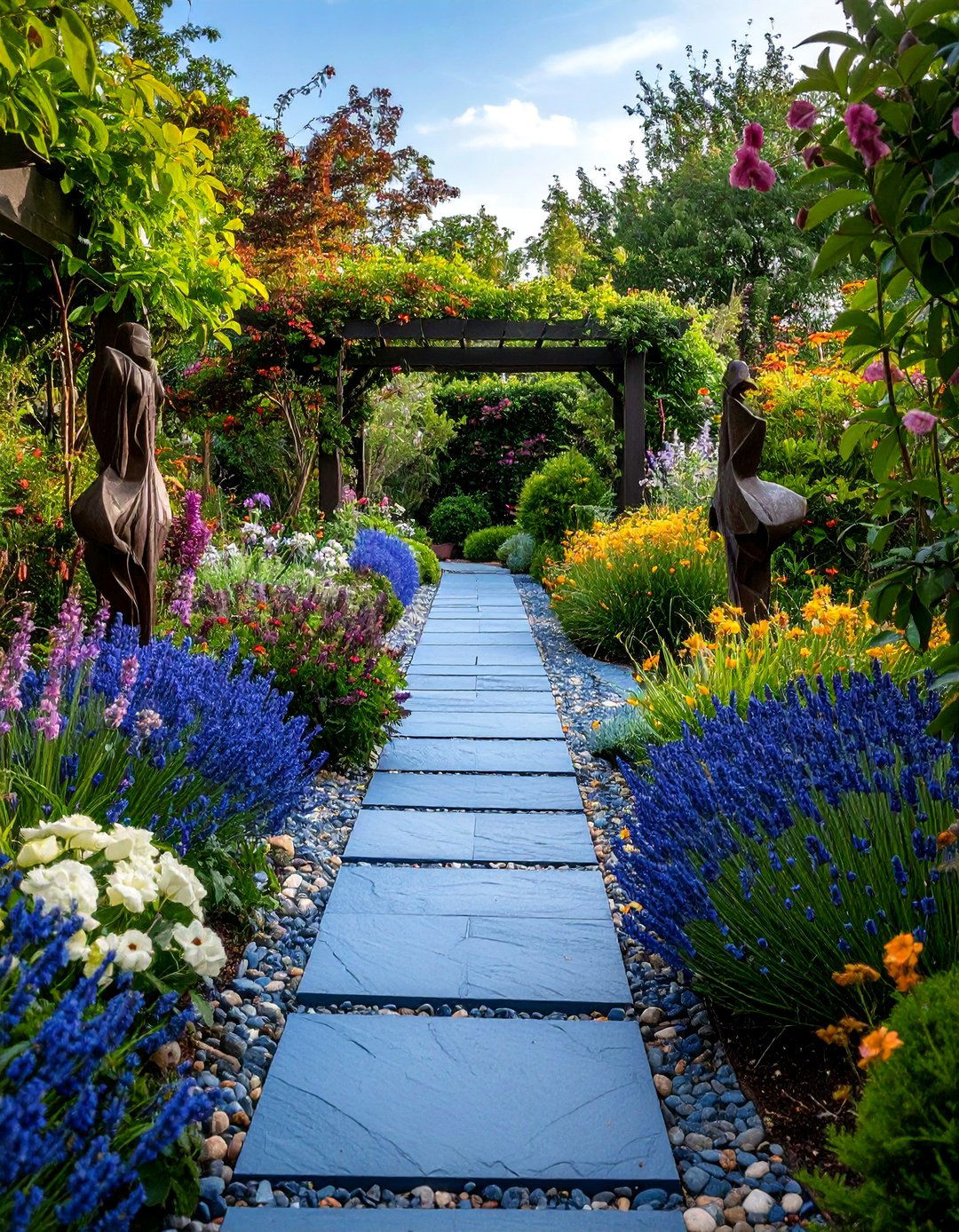
Elevating functional pathways into artistic experiences, a bluestone walkway with sculptural element integration transforms simple transit routes into curated gallery spaces that celebrate both movement and pause within the landscape. Strategic placement of sculptures, artistic installations, or decorative objects along the pathway creates focal points that encourage visitors to slow down and engage with the garden environment on multiple levels. The neutral tones and solid presence of bluestone provide an ideal backdrop for displaying art pieces, whether contemporary metal sculptures, classical stone carvings, or custom installations that reflect personal taste and garden themes. Careful consideration of scale, placement, and sight lines ensures that sculptural elements enhance rather than overwhelm the pathway experience while creating memorable moments that transform routine walks into enriching encounters with art. This approach works particularly well in larger gardens where there's sufficient space to develop multiple viewing points and in settings where expressing personal creativity and cultural interests is important to the overall landscape vision.
18. Bluestone Walkway with Retaining Wall Integration

Solving challenging topography with structural elegance, a bluestone walkway with retaining wall integration creates level walking surfaces while managing slopes and preventing erosion through coordinated hardscape design. The retaining walls, constructed from matching or complementary stone materials, provide necessary structural support while creating opportunities for integrated seating, planted terraces, or decorative features that enhance the pathway's functionality and appeal. This approach transforms potentially problematic sloped areas into assets that add architectural interest and create microclimates for specialized plantings. Proper engineering ensures adequate drainage behind retaining walls while design coordination between the walkway and walls creates visual continuity that feels intentional rather than reactive. The vertical surfaces of retaining walls also provide opportunities for integrated lighting, water features, or planted alcoves that add layers of interest to the pathway experience. This sophisticated solution works particularly well in hillside properties, terraced gardens, or anywhere that functional infrastructure needs to be transformed into attractive landscape features.
19. Wide Bluestone Walkway with Central Planting Strip
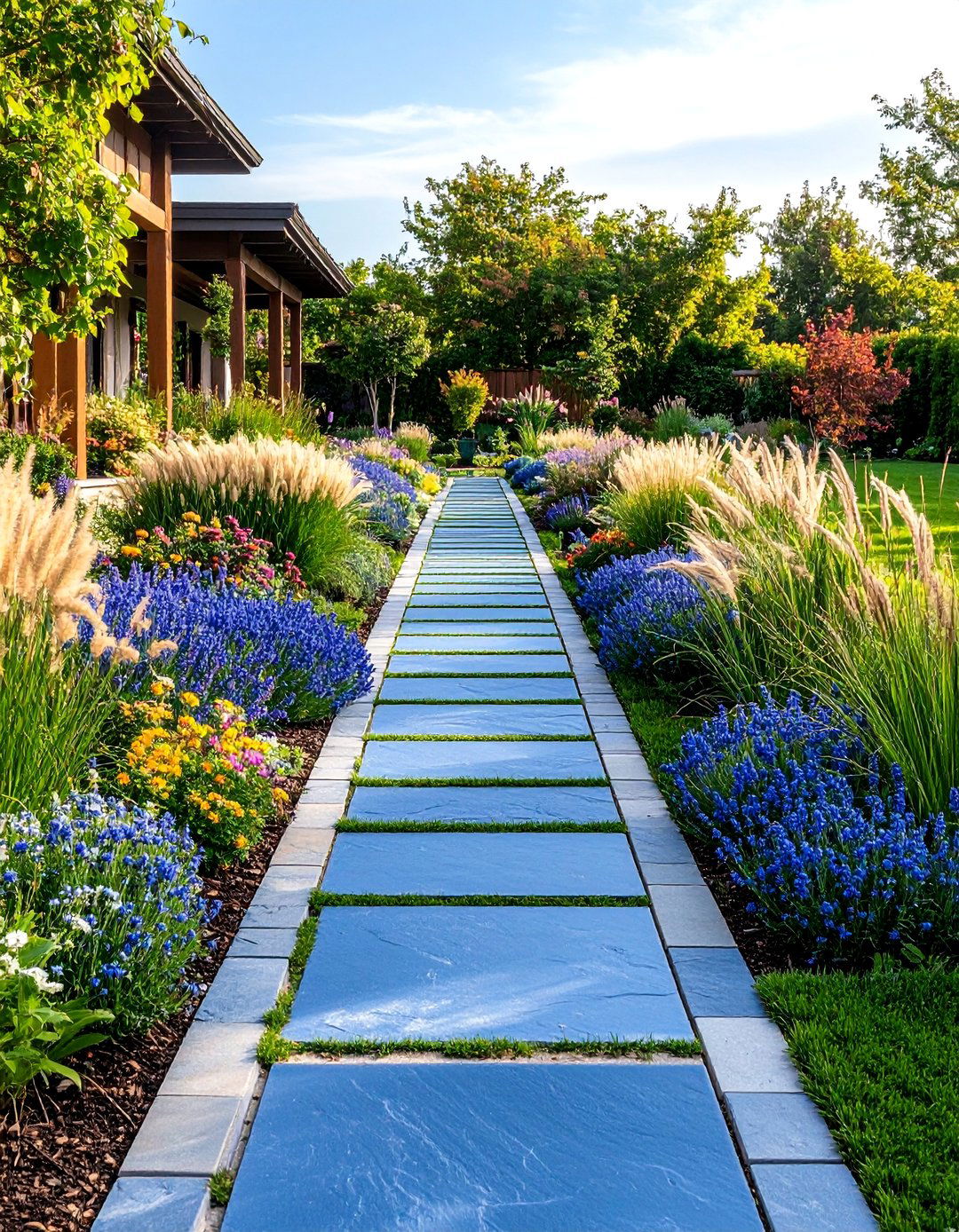
Creating dynamic visual interest through divided pathways, a wide bluestone walkway with central planting strip offers an elegant solution for areas requiring broader pedestrian access while maintaining intimate scale and garden integration. The central planted area breaks up expansive stone surfaces while providing opportunities for seasonal color, fragrance, and texture that changes throughout the year. This design approach works particularly well for main approaches to homes, connections between outdoor entertaining areas, or pathways that need to accommodate multiple users while avoiding the institutional appearance of overly wide solid surfaces. Plant selection for the central strip should consider mature size, maintenance requirements, and seasonal characteristics to ensure year-round appeal without creating maintenance challenges or sight line obstructions. Options include ornamental grasses that provide movement and texture, perennial borders that offer seasonal color progression, or dwarf shrubs that provide structure and winter interest while remaining appropriately scaled for the pathway width.
20. Bluestone Walkway with Decorative Inlay Patterns
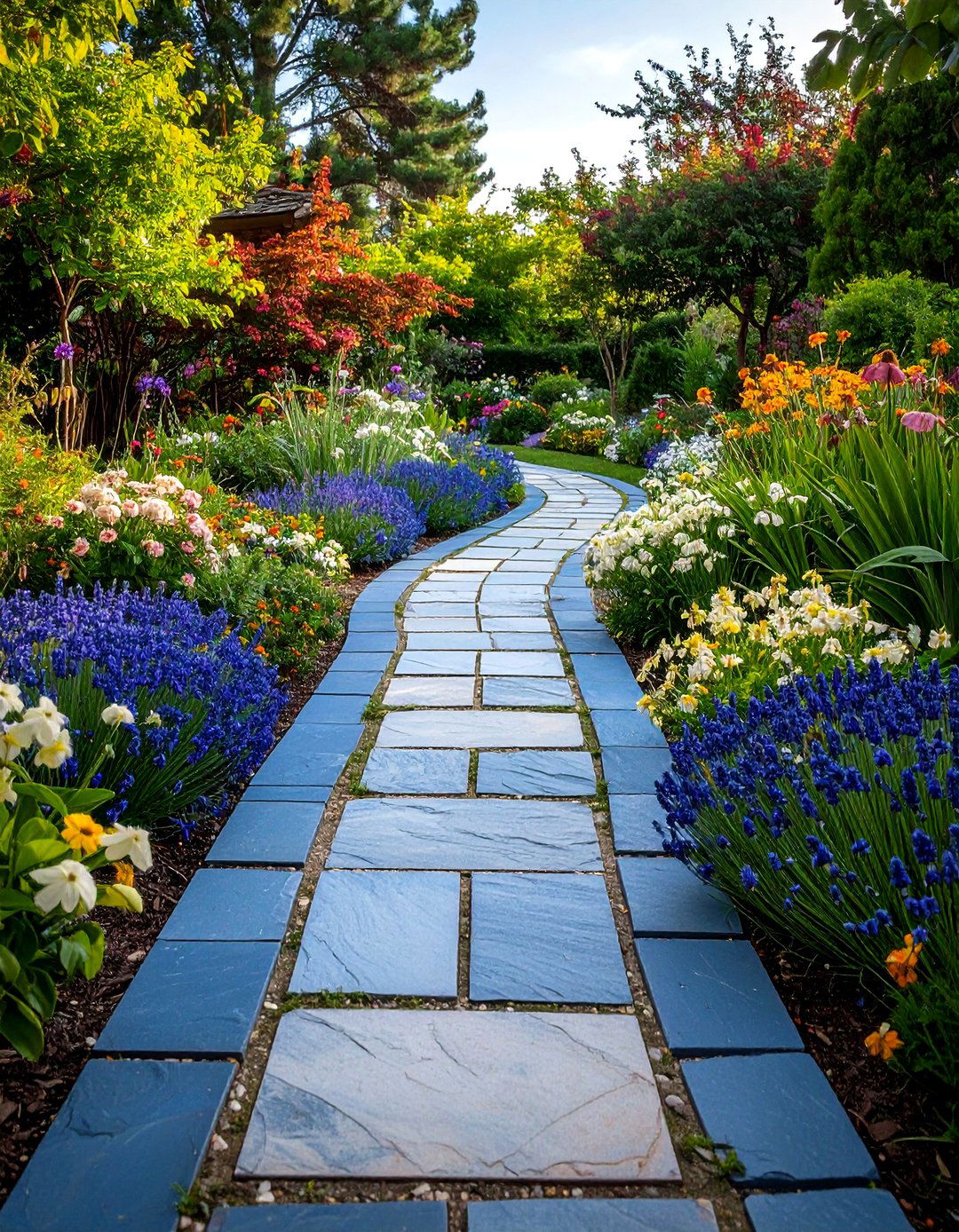
Showcasing artistic craftsmanship through detailed stonework, a bluestone walkway with decorative inlay patterns elevates functional pathways into sophisticated design statements that demonstrate attention to quality and artistic vision. Contrasting stone materials such as granite, marble, or different colored bluestone can be carefully cut and fitted to create geometric patterns, floral motifs, or custom designs that reflect personal style and complement architectural details. This premium approach requires skilled stonework and careful planning to ensure proper fit and long-term stability while creating visual interest that rewards close examination. The inlay patterns can range from simple border details to complex central medallions that serve as focal points along the pathway route. While more expensive and time-consuming than simple layouts, decorative inlays create unique pathways that significantly enhance property value and provide distinctive character that sets the landscape apart from standard installations. This technique works particularly well for formal gardens, historic properties, or anywhere that expressing sophisticated design sensibility is a priority.
Conclusion:
These 20 bluestone walkway ideas demonstrate the remarkable versatility and enduring appeal of this premium natural stone material. From simple straight paths to elaborate artistic installations, bluestone adapts to complement any landscape style while providing the durability and safety that modern homeowners require. Whether you're drawn to rustic natural finishes or prefer the refined consistency of thermal surfaces, these design concepts offer inspiration for creating pathways that serve as both functional routes and beautiful landscape features. The key to success lies in selecting approaches that harmonize with your home's architecture, existing landscape character, and personal aesthetic preferences while considering practical factors such as maintenance requirements, budget constraints, and local climate conditions for lasting satisfaction.


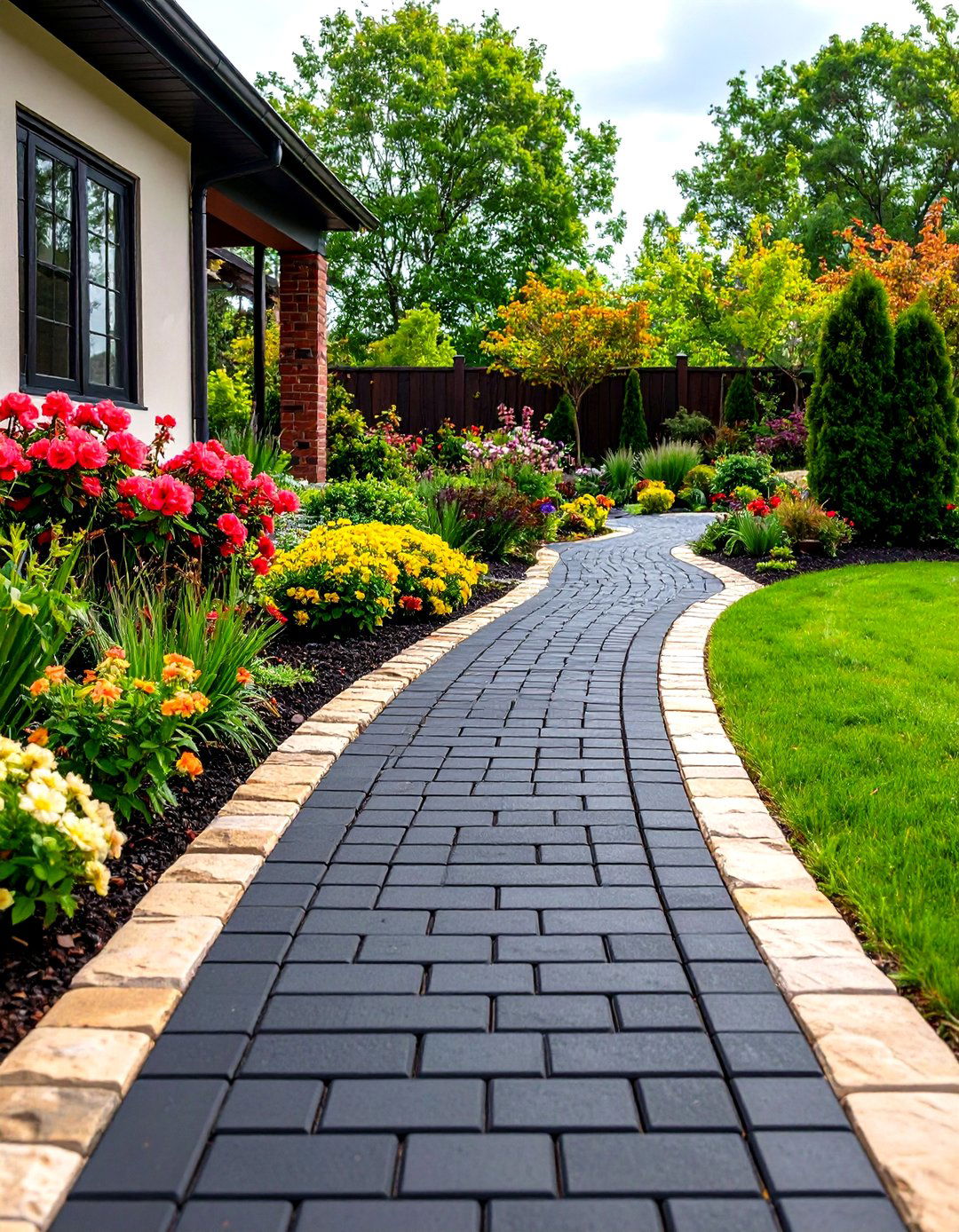

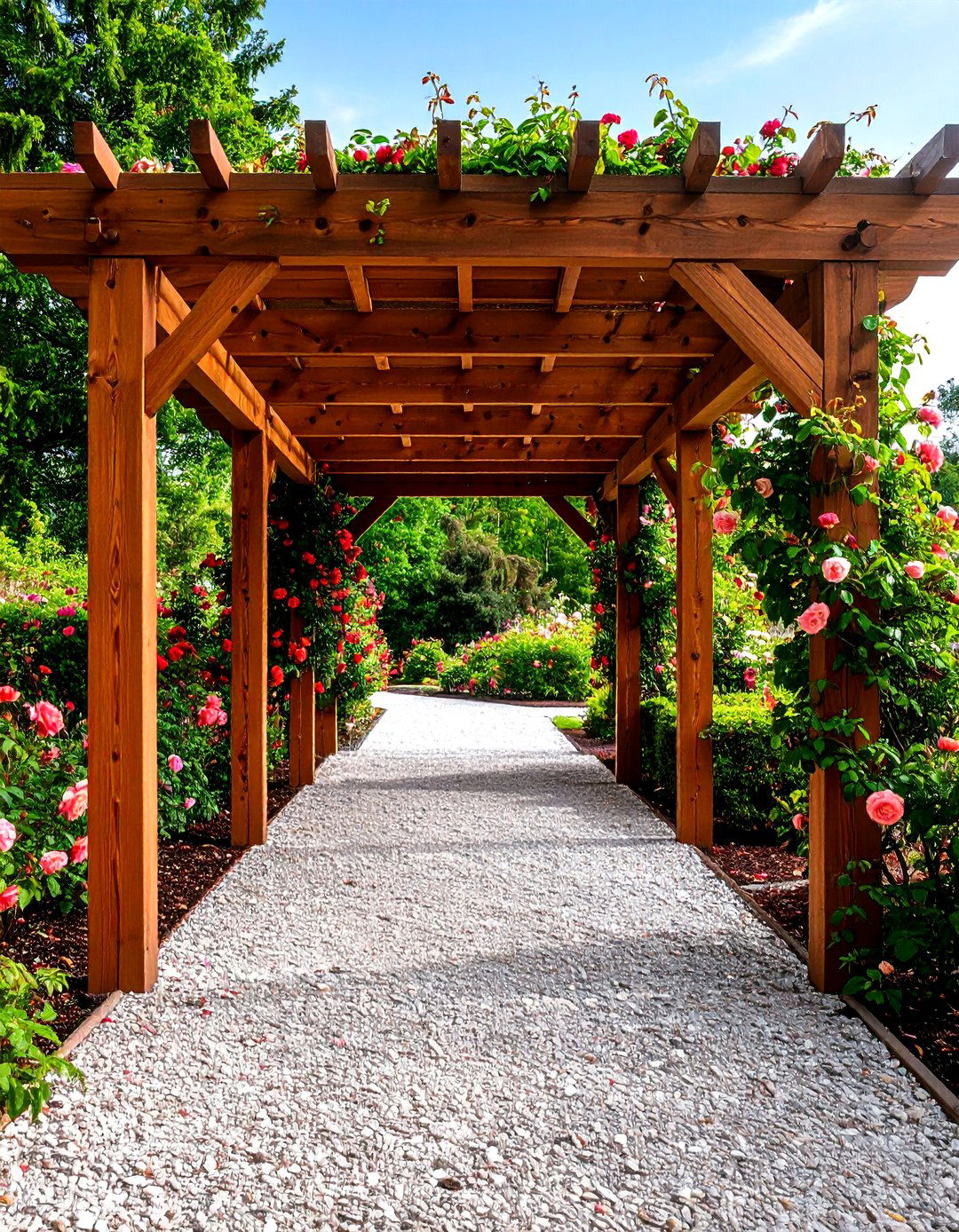
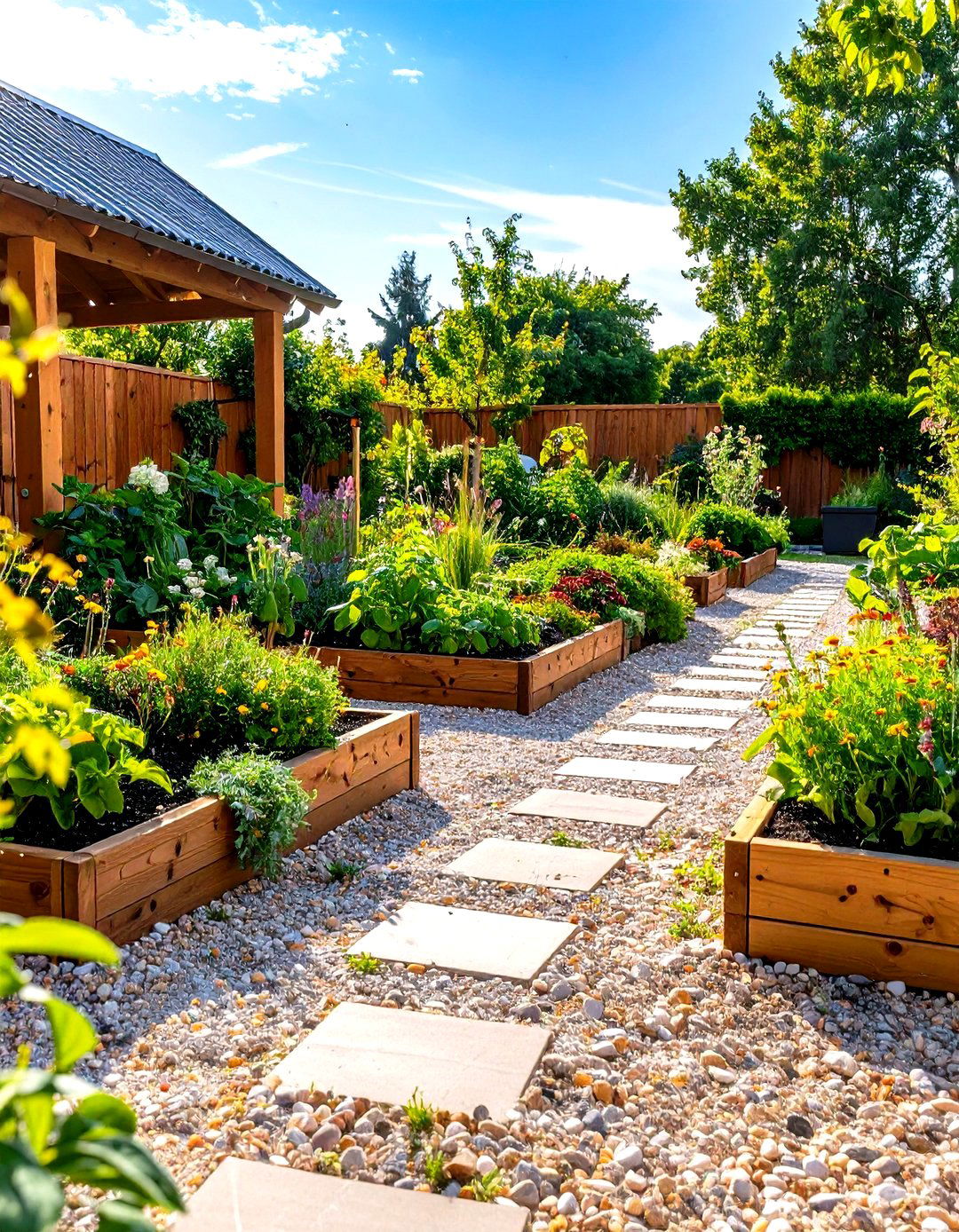
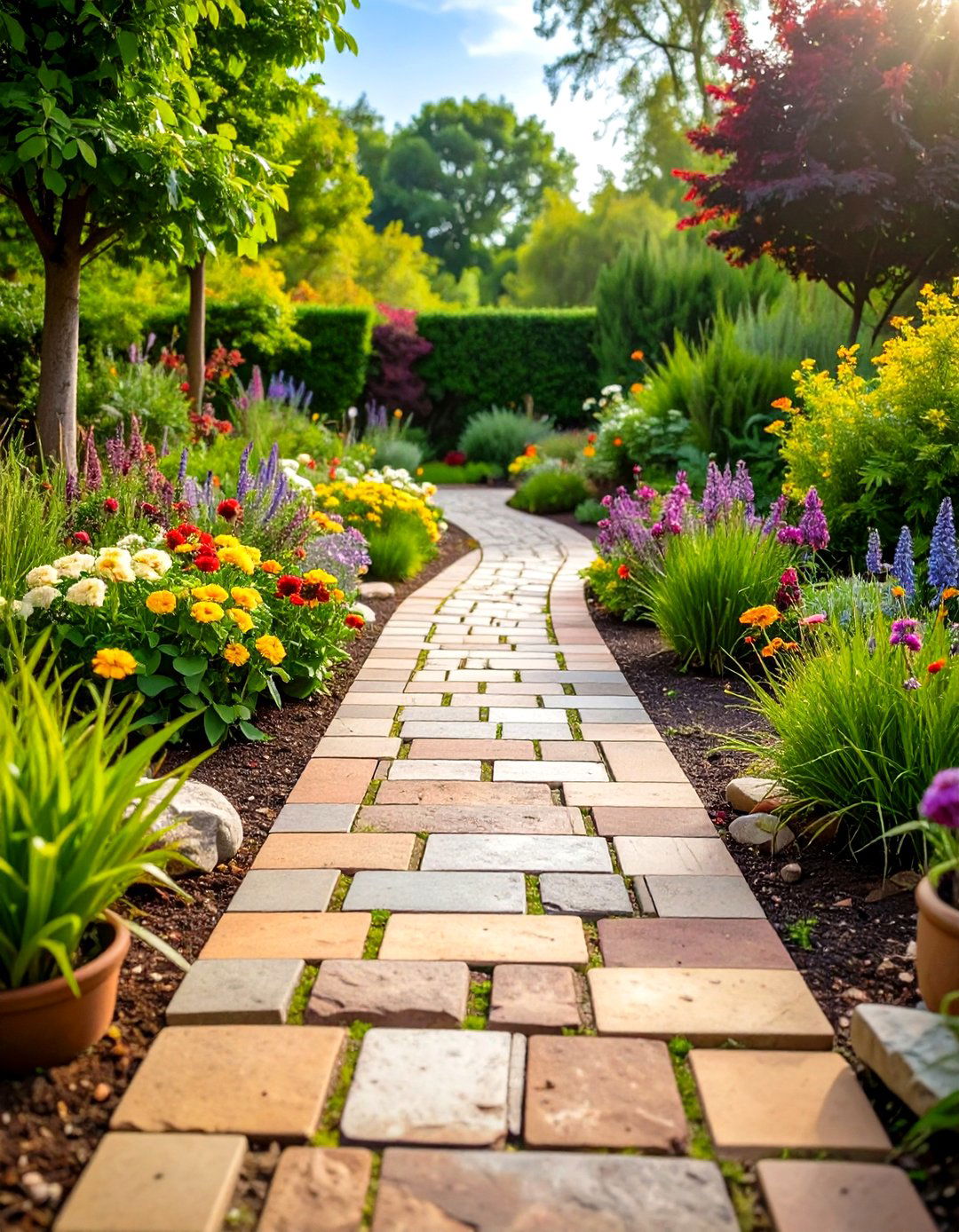
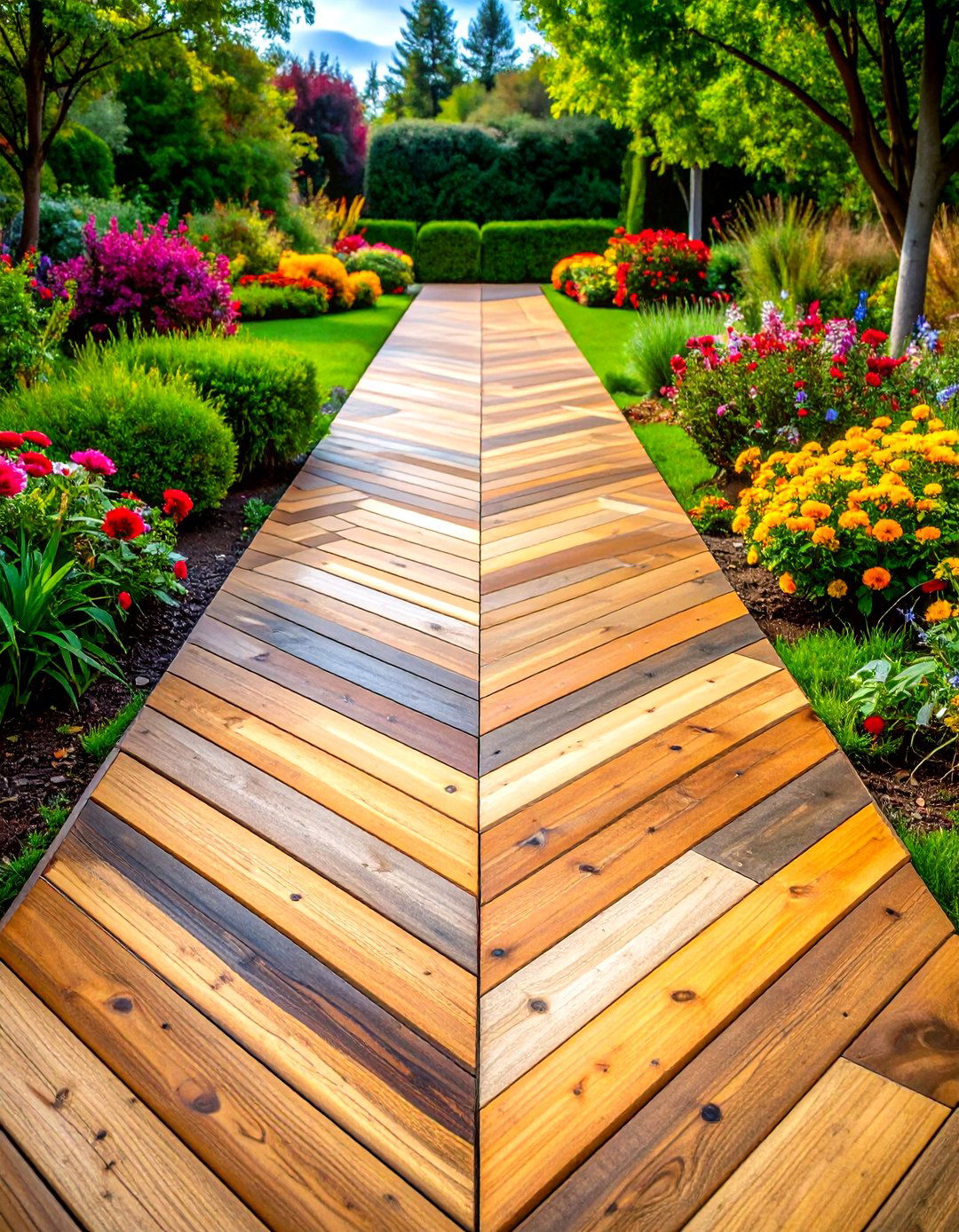

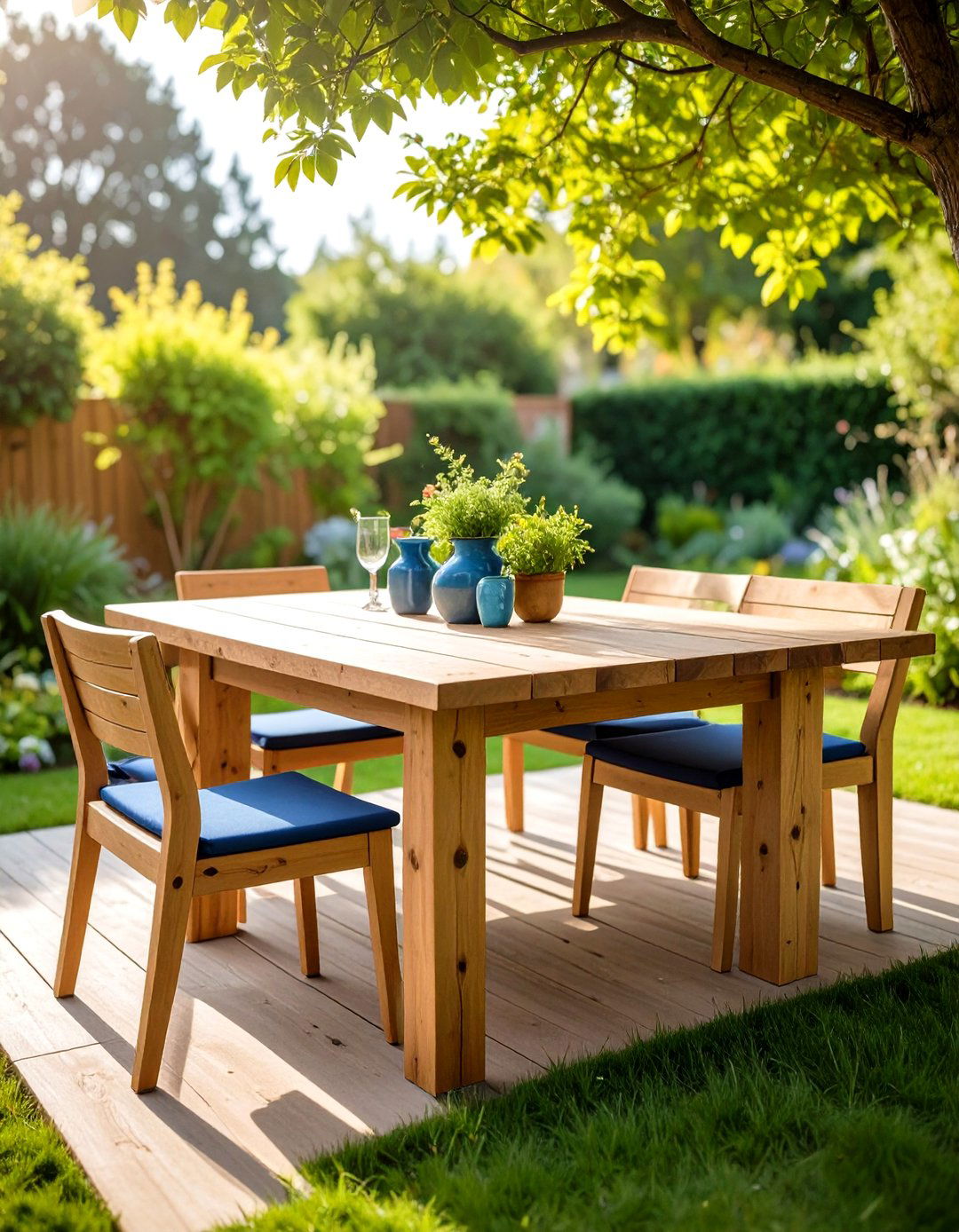
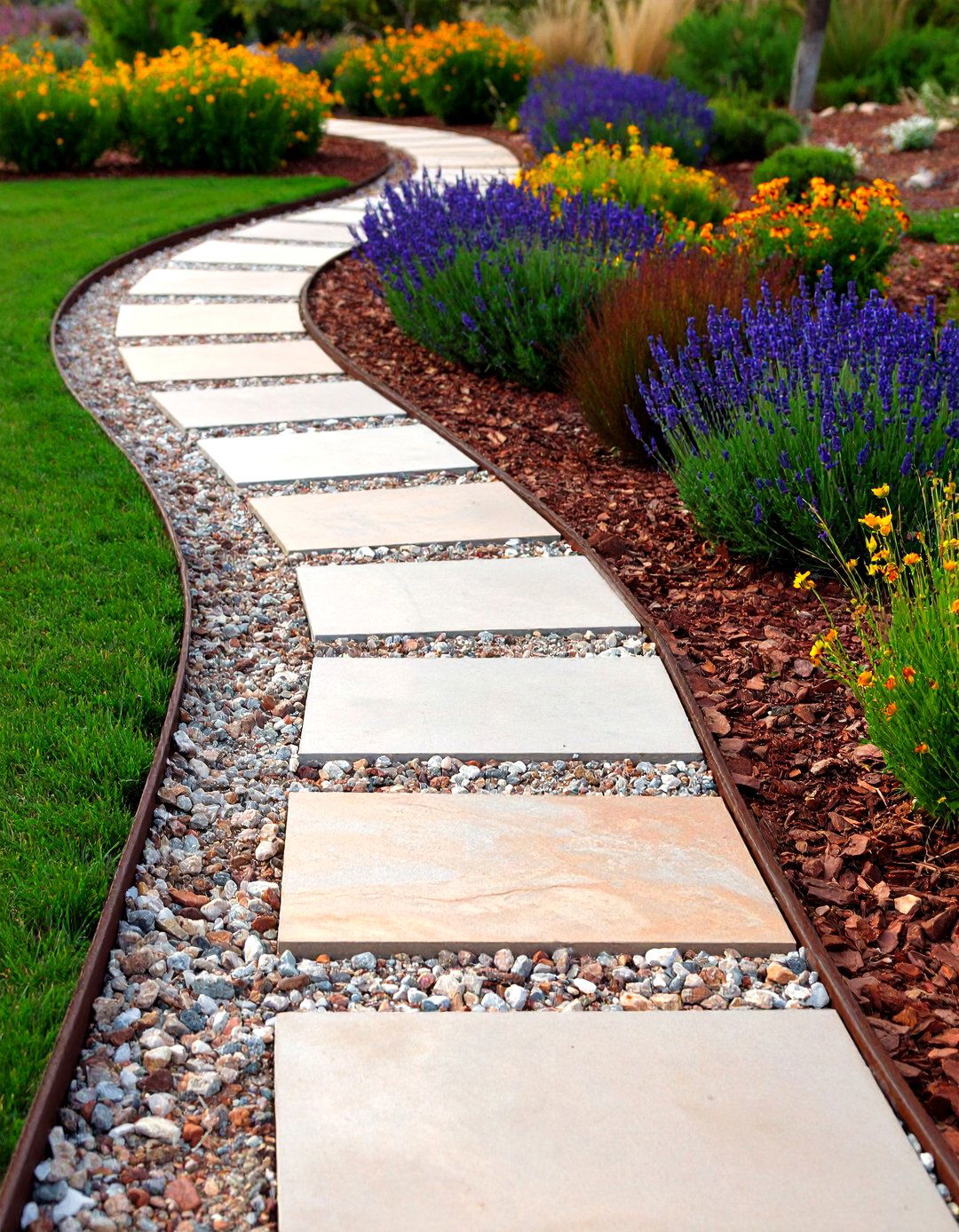
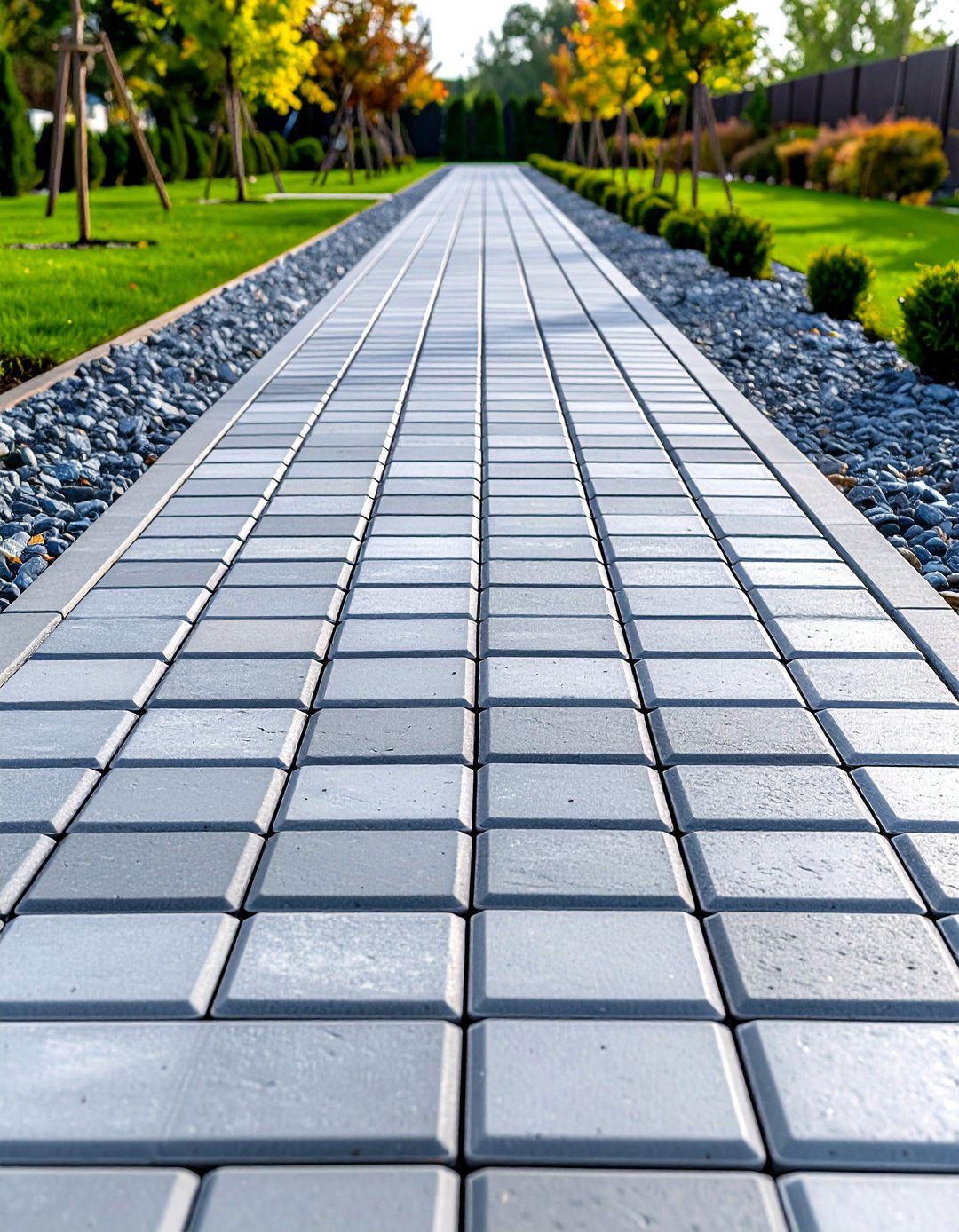

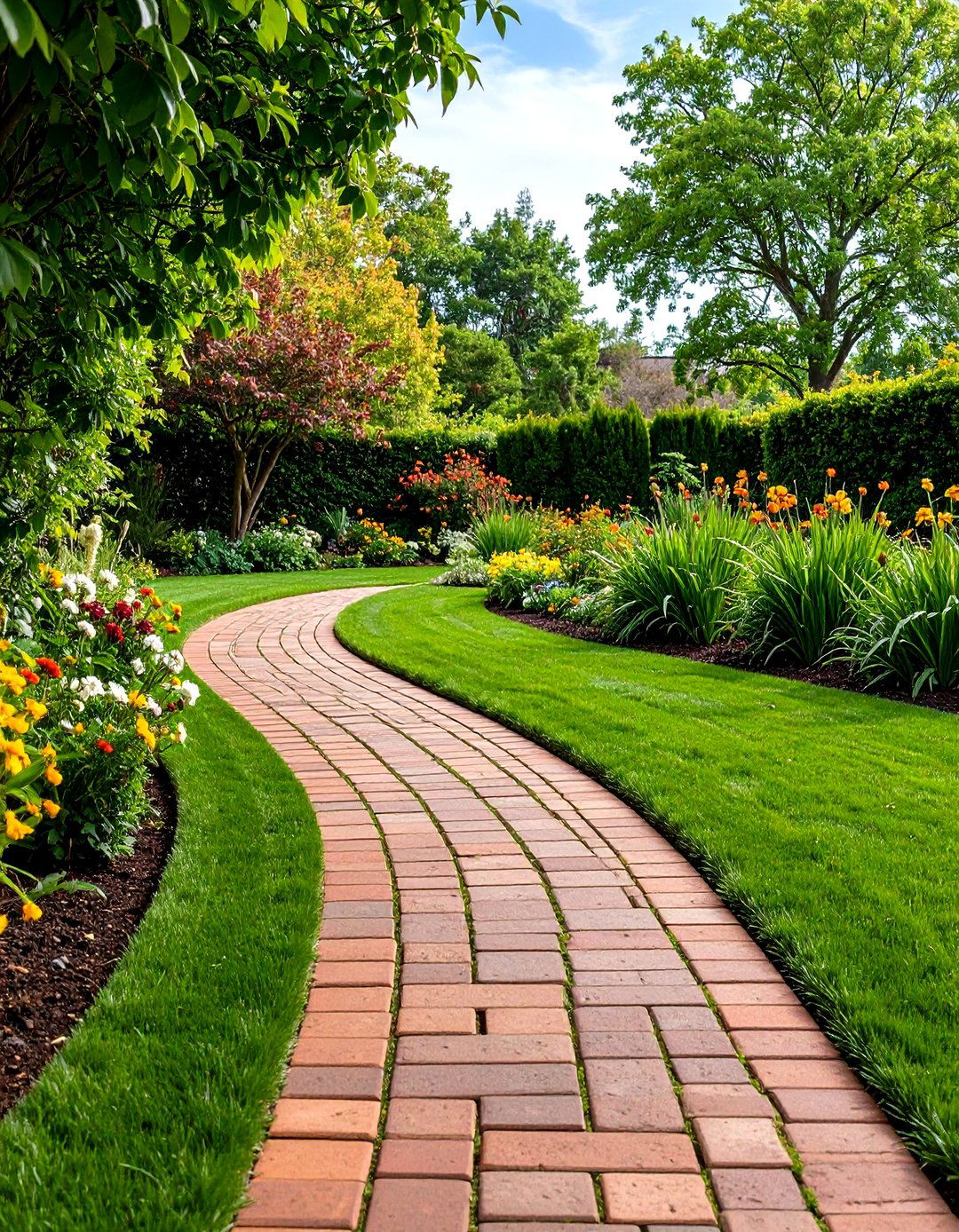

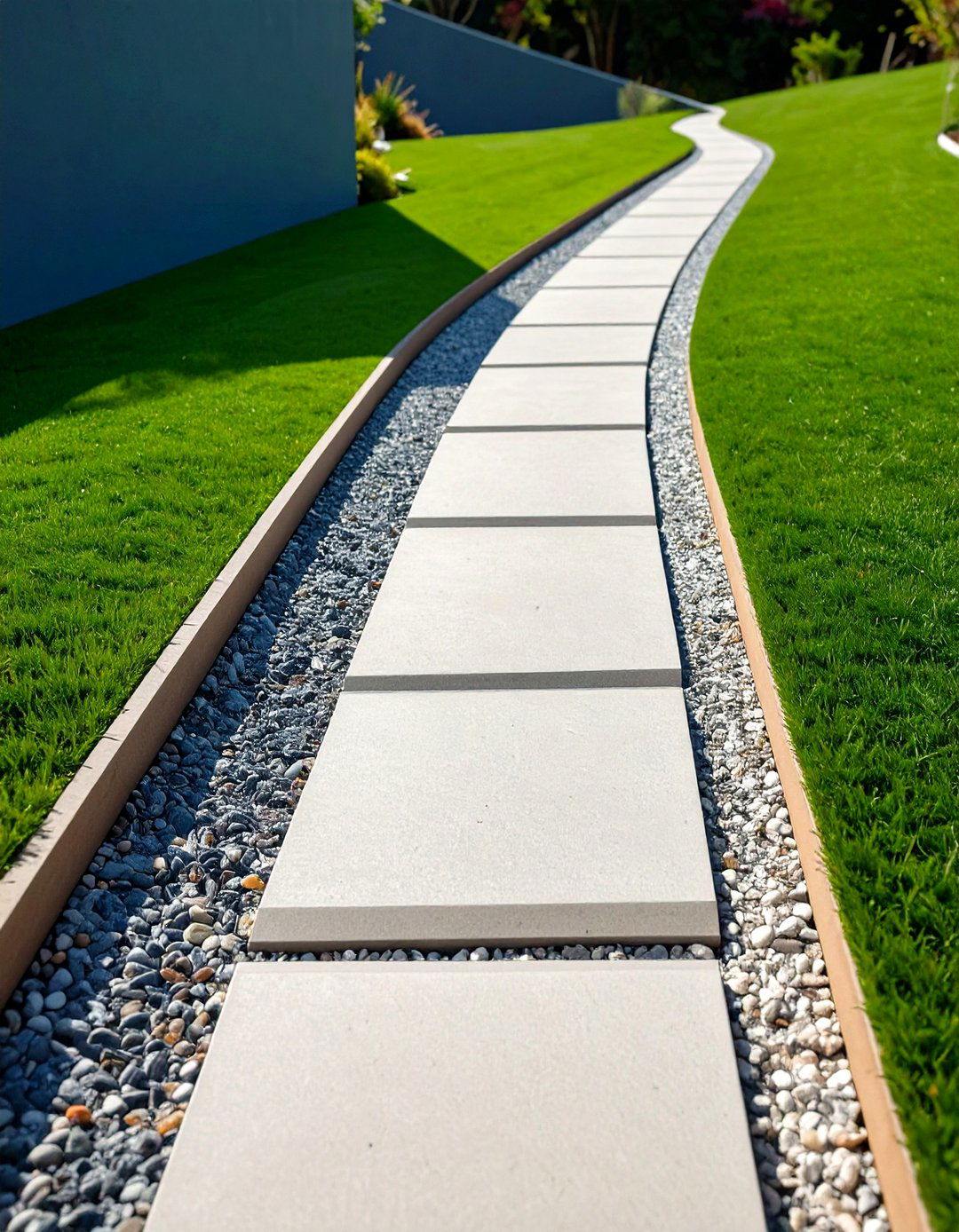
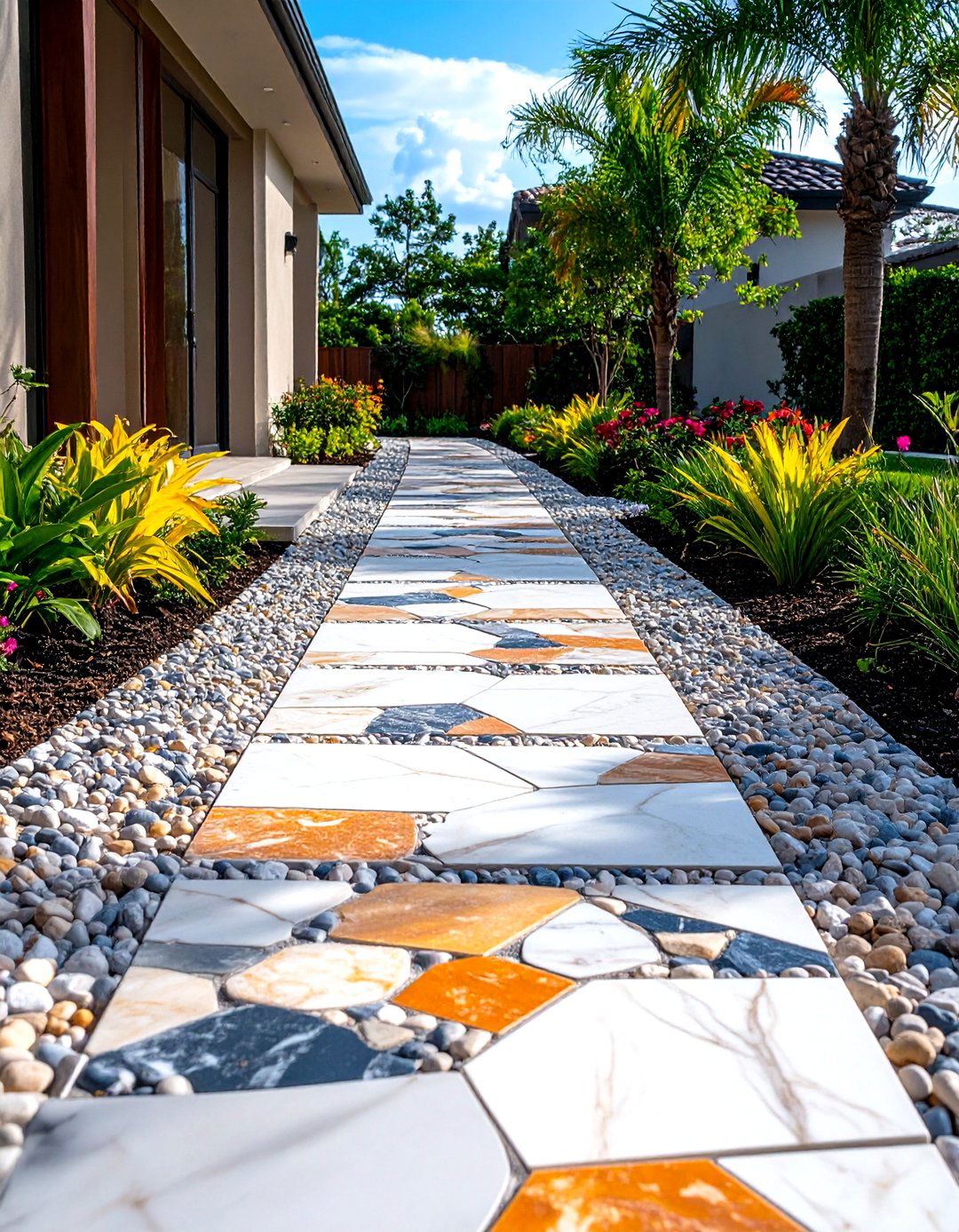
Leave a Reply